#How to screenshot on a macbook pro
Explore tagged Tumblr posts
Text
#How to screenshot on mac#how to screenshot on mac pro#screenshot macbook#united states#usa news#tech news#mac#macbook
0 notes
Text
Easily Connect External Displays to a 2017 MacBook Pro
The 2017 MacBook Pro is a powerful and versatile laptop with many features and capabilities.
However, the Mac has many features, and it is important to learn it. Suppose you want to learn the basic features of Mac, like how to screenshot on Mac, how to use Mac, etc.
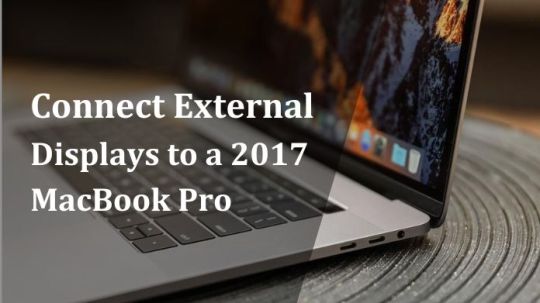
Then, must visit the mentioned blogging site. Here, you get all the information related to this term.
Although the 2017 MacBook Pro is a potent and adaptable laptop, adding an external display is a wonderful alternative to increase your workspace or view material on a bigger screen.
This thorough instruction will take you through every step of the process, whether you need to extend your desktop for more screen space or mirror your MacBook's screen for a presentation.
Overview of the 2017 MacBook Pro
Apple created the potent and adaptable 2017 MacBook Pro laptop. It rapidly became a favorite among professionals and creative people thanks to its svelte appearance, outstanding performance, and high-resolution Retina display.
However, the MacBook Pro's ability to connect to additional displays makes it one of its prominent features.
It enables users to enlarge their workspace, mirror their screen, or view content on a bigger screen.
This complete guide will explain the benefits of attaching extra displays to your 2017 MacBook Pro and walk you through the process step-by-step.
Need to Connect External Displays to a 2017 MacBook Pro
You should connect an extra display to your 2017 MacBook Pro for several reasons.
Productivity Gains: Attaching an external display can considerably boost your productivity.
Having numerous apps and windows active at once makes multitasking simple.
Enhanced Graphics and Video Editing: An external display with excellent resolution and color accuracy can offer a more precise and immersive workspace whether you're a creative professional working with graphics, video editing, or 3D modeling.
Gaming and Entertainment: When playing games on an external monitor, gamers can use a bigger screen and greater graphics performance.
You can watch movies, stream content, or share presentations on a bigger screen for entertainment, which enhances the viewing experience.
Collaboration and Presentations: An external monitor can be quite helpful for sharing your work with others in a conference room or during a meeting when working in teams or presenting presentations.
Extended Desktop: You may extend your desktop with an external display, giving you more screen space for different tasks.
This is especially helpful when handling numerous papers or complex data.
Now that we know how crucial connecting an external monitor to a 2017 MacBook Pro is, let's dig into the detailed instructions.
Requirements for Connecting an External Display to a 2017 MacBook
Ensure you have the following before connecting your 2017 MacBook Pro to an external monitor.
Compatible Display
Make sure you have an appropriate external display.
You'll need a monitor that supports Thunderbolt 3 (USB-C) because the 2017 MacBook Pro has these connectors.
To ensure compatibility, check the specifications of your display.
Correct Cable or Adapter
A suitable cable or adapter will probably be required to connect your MacBook to the external display.
You may require a USB-C to HDMI adaptor or a USB-C to DisplayPort cable, depending on the connection type of your display (HDMI, DisplayPort, VGA, etc.).
Latest macOS Updates
Make sure the most recent macOS version is installed on your MacBook Pro.
Maintaining your system's compatibility is essential, and Apple frequently provides updates that do so.
Steps to Connect External Displays to a 2017 MacBook Pro
When you have everything you require, connect your external display to your 2017 MacBook Pro by following these instructions.
Step 1: Power Off Your MacBook Pro
To prevent potential problems or damage, turn off your MacBook Pro before connecting any cables.
Step 2: Connect the Cable or Adapter
Connect the cable or adapter's one end to the MacBook Pro's Thunderbolt 3 (USB-C) port and the other to your external monitor.
Verify the security of the connection.
Step 3: Power On Your External Display
Check the input source on your external display before turning it on. Use the display's buttons or remote to change to the proper input if necessary.
Step 4: MacBook Pro Setup
Your MacBook Pro should instantly detect the external display once it is turned on and attached.
Alternatively, select "System Preferences" > "Displays." The display's arrangement, resolution, and mirroring settings can change here.
Step 5: Configure Display Settings
Mirror Displays: Select "Mirror Displays" to mirror your MacBook Pro's screen on an external monitor.
This is useful if you want the same content on two screens or for presentations.
Extend Displays: Uncheck "Mirror Displays" to spread your desktop across both displays. You have greater room to multitask as a result.
Step 6: Adjust Resolution and Arrangement
You can modify the resolution and configuration of your displays in the "Displays" settings to suit your tastes.
To arrange the displays on your desk as they are set up, drag & drop them there.
Step 7: Enjoy Your Dual Monitor Setup
Your external monitor is currently set up and connected.
Whether you want to use a larger screen for work, enjoyment, or productivity, you can profit from them.
Troubleshooting Tips
Consider these troubleshooting suggestions if you encounter difficulties throughout the setup procedure.
Check Cable Connections: Make sure all wires are firmly connected by checking the connections.
Restart your MacBook: Restarting your computer might sometimes solve connectivity problems.
Try Another Cable or Adapter: Make sure your macOS and graphics drivers are up to date by updating them. If the display is still not functioning, try using a new cable or adapter.
Check Monitor Compatibility: Make sure your external display is compatible with your MacBook Pro by checking the monitor compatibility.
Conclusion
Your computing experience can be greatly improved by adding an extra monitor to your 2017 MacBook Pro, giving you more screen space for work and entertainment.
You can set up and use a dual monitor setup without any problems if you follow the instructions in this article and consider the troubleshooting advice.
Connecting an external monitor is a useful and simple operation, whether you're a professional looking to increase productivity or just want a bigger screen for viewing movies.
1 note
·
View note
Note
may i please ask how you keep your game running smoothly on mac? while my game is fine most of time, I experience lag there and there. and if its not too much, how much storage do you have and how big is your mods folder? -fellow mac user!
Hi Channy! It's so hard out here for us Mac users, lol.
Keep reading for my computer specs + additional tips to help reduce lag:
My Specs
Processing Chip: I have a 2020 M1 MacBook Pro, with an Apple M1 processing chip. I think this is important because the Apple "M" processing chips are far better than the Intel chips. I had a MacBook with an Intel chip for years before finally upgrading my laptop... huge difference.
Memory: I currently have 8 GBs of memory.
Storage: In terms of storage, I have 232.87 GB available of 494.38 GB total. Of that, my Mods folder is 54.58 GB.
Sims 4: I own all of the EP's, GP's, SP's, and Kits. My in-game graphics settings are fairly high. Only because I refuse to compromise on my nice screenshots, lol.
I do not merge custom content. I used to - but now I prefer to separate items and delete items that I do not use. Random potted plant that came with some random set that I never use? Delete. Hairstyle that I skip every time? Delete. I have been careful about only keeping items that I actually love.
Recently, I have been experiencing minor lags, but that's only because I have been playing my current save for quite some time.
Tips to Help Reduce lag for Mac Users:
Merge custom content. I know I just said that I no longer do this, but I used to swear by this method. Apparently, the game does not care about the size of the files, only the number of files that it has to read. Having a small amount of really huge files is much better than making the game read hundreds of individual files.
Delete "localthumbcache.package" in your 'The Sims 4' folder. Don't worry, the game will generate a new one. If you have been playing the game for a while (without deleting this) - this file tends to bloat which causes the game to lag.
Use less clutter... especially if you are using custom content. I cannot stress this enough. The more items you have on the lot - the more the game will lag. Your computer is being forced to read all of this visual information - and it's in overload. There's a reason those EA lots are practically empty.
I hope this helped just a litttttle bit 🤎
13 notes
·
View notes
Note
How do you like make the screenshots of the game look good? I want to start my own legacy challenge and post it but idk how to make it look nice? :)
I use Reshade to take my in-game pictures. If you have a computer that can handle Reshade then you can follow some really neat tutorials that help you install and understand how to use it - @pictureamoebae has heaps. I only useReshade to take my pictures, I don’t play with it on as I use quite heavy settings.
I also edit my images in photoshop to add on extra coloring and sharpening/cropping. In my FAQ I’ve posted the exact presets I use for editing my pictures.
That all being said, there are heaps of Legacy Challenges that don't use heavy editting and are still beautiful! A lot of it comes down to how you use angles and cropping to create a great shot that speaks for itself. I look back at the images I was creating when I started - I was only using Photoshop and running on a Macbook Pro - and can tell my style and skill have changed heaps over time as I've played around with things and learnt more. So don't let it put you off starting!


1890 (taken in 2020) vs 1970 (taken in 2022)
21 notes
·
View notes
Text
Liquid Glass Excitement
I can't lie I'm practically counting down the days. Apple’s upcoming Liquid Glass UI is everything.
The more I see, the more I stare, and the more I want. It’s not just another visual refresh it’s a full-on experience shift, something we haven’t seen at this scale since iOS 7 dropped and turned the entire design world on its head.
Back then, people scoffed at flat design. They said Apple had lost its mind ditching skeuomorphism. But look who was right. Apple led, and the rest of the industry followed. Now, with Liquid Glass, they’re about to do it again—this time with depth, motion, and glassy realism that makes your screen feel alive.
What Is Liquid Glass?
If you haven’t been glued to every WWDC leak and developer preview like I have first of all, shame on you but here’s the scoop: Liquid Glass is Apple’s next gen design language, and it's as if iOS, macOS, and visionOS had a baby made of light, depth, and liquid elegance.
It’s not gimmicky. It’s not Android’s cluttered chaos or Windows 11’s half-baked attempts at polish. This is something crafted. Something intentional. Layers of UI that move with you. Interfaces that look like actual flowing glass—cool, clean, futuristic. And paired with Spatial Audio and Apple’s already tight haptics? Chef’s kiss.

Why I’m Losing My Mind (In the Best Way)
I’ve already got my iPhone 16 Pro, iPad Pro, and MacBook Pro polished and waiting. You know that silver body with the M4 Max chip is going to look untouchable with that new Liquid Glass look. I’ve seen the preview videos, the demo screenshots, the developer kit sneak peeks and it’s nothing short of mesmerising.
Apple isn’t just updating the UI they’re changing how we interact with our devices. This is like when touchscreens first became standard. Like when Retina displays made everything else look pixelated and sad. Like when Apple Silicon blew Intel out of the water.
Liquid Glass is the next evolution. And I want it on everything.

This Will Shake Heads Mark My Words
Some people are still downplaying it. “Oh, it’s just a new coat of paint.” These are the same people who said the iPhone wouldn’t catch on. Or that iPads were just big iPhones. Or that M1 was overhyped. We all know how that turned out.
Mark my words: Liquid Glass will redefine what premium software feels like. It will set the tone for design in the next decade. From the UI transitions to the depth-based effects, this isn’t just a style change it’s Apple flexing again. Quietly, confidently, as only they do.

It’s more than a visual shift it’s a feeling. A mood. A promise that Apple still knows how to surprise us in an era where most tech feels... stale. The ecosystem is about to feel more alive, more intuitive, and, frankly, more Apple.
So yeah, I’m ready. iPhone 16 Pro? Locked and loaded. iPad Pro? Already looking futuristic. MacBook Pro? Can’t wait to see Liquid Glass breathe through that gorgeous 16-inch display.
And to all the doubters? Just wait. This will be one of those “Where were you when...” Apple moments. Just like iOS 7. Just like the first Retina Mac.
History, my friends, is about to repeat itself with style.
#Apple#LiquidGlass#iOS18#iPadOS#macOS#DesignLanguage#iPhone16Pro#M4Max#AppleEcosystem#WWDC2025#UIRevolution#TechDesign#MacBookPro#AppleAesthetic#SpatialDesign#AppleObsessed#ConservativeTech#AppleIsBack#iOS7Vibes#DepthDesign
0 notes
Text
i love looking at how people interact with their tech but unfortunately i have only myself to observe. I have substantially altered my file organization methods over the course of the past decade, and it was all very UI-driven.
The first computer I personally owned was a 2013 Macbook Pro and, like, my whole life was on the desktop. Documents went on the right, images went on the left. Once that started being cluttered, I began sorting things into folders, but it was all still on the desktop.
When I had to move from the Macbook to my Lenovo Thinkpad, a Windows machine, I dumped everything into a folder labeled "Suitcase" and transferred it via flash drive so I could set up my system over again. The folder lived in the middle-right of the desktop and I never got around to fully unpacking it.
Over time, I started using my documents folder and the file explorer more and more. By the time I transferred from the Thinkpad to my current Framework laptop, I had a relatively small number of things to copy over from the desktop--the lion's share of the stuff I needed to move belonged in dedicated folders in my file directory, which could be copied over and dropped into the new PC's file directory seamlessly.
This transition marked the end of my reliance on the desktop--all stray files got sorted into the appropriate folder in my file directory. Now, my desktop literally looks like this (and no, I didn't clean this up for the screenshot, I'm just like this now):

(Art is from the Golden Treasure: The Great Green btw. love that game.)
0 notes
Text
VeryPDF Website Screenshot API for Developers
How to Use VeryPDF Website Screenshot API for Developers to Capture Full-Page Screenshots in Seconds
Meta Description: Capture pixel-perfect full-page screenshots in seconds using VeryPDF Website Screenshot API—built for developers who need reliability, scale, and speed.

Every developer has hit this wall.
You’re building a dashboard or automating reports, and someone on your team says, “Can we just drop in a live screenshot of the page?” You think: Sure, I’ll just use an open-source tool.
A few hours later, you’re buried in headless browser configs, broken rendering, and timing issues where content loads after the shot’s already taken.
I’ve been there. More times than I want to admit.
This is why when I stumbled on VeryPDF Website Screenshot API for Developers, it felt like skipping the queue straight to the solution. No more fiddling with Puppeteer or spinning up Chrome instances. Just one call to the API, and boom—full-page, retina-quality screenshots in any format I needed.
Let me walk you through how this tool saved my time, my sanity, and probably my server bill.
The Problem With Most Screenshot Tools Let’s be honest.
Most “free” or “open-source” screenshot solutions are a headache. They break on:
Lazy-loaded content
Single-page apps
Sticky headers or parallax
Mobile views
Cookie pop-ups and ads
And don’t get me started on maintenance. Keeping a headless browser updated and rendering properly across different environments? That’s a full-time job.
Even the paid tools I tried didn’t scale well. I once had to generate 500,000 screenshots for a client’s SEO archive project. The tool I was using crumbled after 20,000.
That’s when I found VeryPDF’s Website Screenshot API.
Why VeryPDF Screenshot API is Built Differently This isn’t just a Chrome wrapper.
This thing is built on Chrome + AWS Lambda, designed to scale from 1 to over a million screenshots per month. I put it to the test on a real project involving weekly newsletter screenshots for over 600 clients—worked flawlessly.
Here’s how it works:
You call the API with a URL and desired output (JPG, PNG, PDF, or WebP)
It renders a pixel-perfect, full-page screenshot
You get it delivered as a direct file or as JSON response
No need to babysit it. No need to patch updates. And the docs? Actually usable.
Features That Actually Make a Difference Here are a few things that stood out while using it:
Full-Page + Mobile + Custom Viewport You’re not limited to what’s visible above the fold.
You can set it to scroll the full page, emulate mobile devices, or control the viewport width and height precisely.
Use case: I had to generate side-by-side desktop and mobile previews for a web agency’s landing pages. Set two API calls with different widths. Done. No extra code.
Block Annoyances (Ads, Cookie Banners) Ever taken a screenshot only to find a cookie banner covering the CTA?
VeryPDF lets you block those automatically.
This saved me hours when I was creating snapshots for compliance reports. No need to manually filter or edit the images after.
Just add --no-cookie-banner or --no-ads in the query and it’s clean.
HD Retina Output (2x, 3x Resolution) This was a big win.
You can request screenshots with @2x or @3x resolution, which is clutch if you're producing assets for high-DPI displays.
I used this for an app promo page targeting MacBook Pro users. Result? Razor-sharp screenshots that looked fantastic on retina displays.
How I Used It in a Real Project I had a client who ran a stock trading platform.
They wanted weekly archive PDFs of their homepage, including news tickers, embedded charts, and live data—captured exactly as it appeared to users.
I used VeryPDF’s API like this:
http://online.verypdf.com/api/?apikey=MYAPIKEY&app=html2image&infile=https://clientsite.com&outfile=homepage.pdf
One line. That’s it.
I set a cron job, and every Monday morning the API would capture a full-page, retina-quality PDF of their homepage with zero delay or manual work.
Compared to using headless Chrome with my own server—which took me two days to stabilise and still failed randomly—this was plug-and-play.
Who Should Be Using This API This isn’t just for devs building dashboards.
Here’s who will benefit from it:
SaaS teams needing snapshots for analytics or audit logs
Marketing teams creating before/after visuals
Legal and compliance who archive live content regularly
QA testers capturing layout bugs in different viewports
Developers automating PDF reports from web content
Whether you're doing 1 screenshot a week or 1,000,000 a month, this tool just works. No surprises.
Other Tools vs VeryPDF Let’s break it down.
Headless Chrome? You’ll be maintaining a mini browser farm. Not worth the time.
Open-source tools? Half of them don’t support full-page rendering or break on JavaScript-heavy sites.
Other APIs? Some work, but fall apart at scale or charge insane overage fees.
VeryPDF’s Screenshot API?
Fast
Reliable
Handles complexity
Actually scales
And most importantly, it doesn’t make you feel like you're constantly fixing it.
Want to Try It Out? I highly recommend giving this a shot if you're drowning in manual screenshot tasks or just want a fire-and-forget API that works like it should.
Start here: 👉 https://www.verypdf.com/online/webpage-to-pdf-converter-cloud-api/
You get 100 free screenshots just to try it—no credit card needed.
Need Something Custom-Built? VeryPDF also offers custom development if you’ve got unique needs.
Whether you want this API integrated into your Windows server, a mobile app, or embedded into an existing reporting platform—they’ve got you covered.
They support:
Windows API, Linux, macOS, Android, iOS
C#, Python, PHP, .NET, JavaScript, and more
Custom virtual printers that capture print jobs as PDFs or images
OCR, barcode reading, document parsing, font conversion—you name it
If your team needs tailored PDF or image handling, you can contact their support team here: 👉 http://support.verypdf.com/
FAQs
How do I get started with the API? Visit the product page and grab your free API key. No credit card required.
What file formats are supported? You can export to JPG, PNG, PDF, and WebP.
Can I customise the viewport or resolution? Yes. Set custom width, height, and even device pixel ratio (@2x, @3x).
Is this secure for sensitive data? Yes. All API calls use HTTPS, and you control access with your API key.
Can I schedule automatic screenshots? Absolutely. Use cron jobs or backend triggers with the API for automated capture.
Keywords/Tags: website screenshot API, capture full-page screenshots, html to image api, verypdf screenshot tool, automated webpage snapshots, pdf website screenshot api, developer tools screenshot, chrome rendering screenshot api, scalable image capture API, high-res webpage screenshot tool
From day one, this tool felt like a hidden gem. If you need to capture full-page screenshots fast, reliably, and at scale—VeryPDF Website Screenshot API is the tool I wish I’d found sooner.
0 notes
Text
Increasing Work Efficiency by Renting a MacBook
Has anyone ever told you that MacBooks are only appropriate for professionals? Or are MacBook's advantages most utilised for business or office work?
Apple is renowned for providing incredible goods and services. Whether they are MacBook Pros or iPods, these devices never cease to wow people with their extraordinary features. The MacBooks have been precisely designed and coded to assist and optimise corporate processes and empower employees to get the most out of their jobs.

You may even rent a MacBook to experience it for yourself! However, if you still need some persuasion, check out this article on how using Computer on Rent Mumbai in your workspaces might help you work more efficiently.
Hardware & Software by Apple
There is a significant value addition to the MacBooks that is likely not seen by most users. It is more streamlined and user-friendly when a single business manufactures the hardware and the software internally. You can utilise Mac OS's benefits and top-notch hardware. The best hardware is designed and manufactured, which increases the gadgets' durability. Mac products have a longer lifespan in comparison to other gadgets.
Intuitive User Experience
Among other perks, anyone who utilises a MacBook will have an excellent experience. Putting users first guides the design and development of a user experience. Every feature of Mac's UX design is meant to simplify users' lives. Every primary function and setting remains handy. On MacBooks, it's quite simple to scroll, click, select, take screenshots, and other actions.
Applications
The incredible apps that are available for Macbook on Rent Mumbai are among their most significant advantages. Because of its incredible apps tailored to each job, MacBooks are always preferred by creative, technological, and engineering professionals. These programs support just Mac OS and are incredibly feature-rich. While many more apps function on both platforms, iOS apps provide many unique capabilities.
Security
Finally, security is crucial when choosing the appropriate equipment for your business. Does this imply that cyber attacks against MacBooks never occur? Every technology is subject to cyber attacks. What matters most is the likelihood of being hacked. Less exposure to cyber attacks is one of the main advantages of a MacBook.
Now you can look for a MacBook on rent near me to get the best services from ABCom. They are one of the leading IT equipment rental service providers in Mumbai. Choosing their renting services includes support service, maintenance, and repairs at all times. You can rest assured that you can get a MacBook of your preferred specifications at an affordable cost.
0 notes
Text
How To Edit A Screenshot On Your Mac
Are you a Mac user who needs to edit screenshots quickly and easily? Screenshots are an essential part of the modern workflow, but editing them correctly can be both time-consuming and confusing. You could search for professional software solutions, or you could learn some of the tricks to get your screenshots looking perfect within minutes. In this blog post, we'll reveal how to edit a screenshot on your Mac in no time at all! From simple cropping tools to colour filters that will bring life to any image—we'll cover it all; so if you're ready to start taking your screenshots up a notch then buckle up and let's dive right in!
How to take a screenshot on Mac
If you're a Mac user, taking a screenshot is incredibly easy - and it's a useful skill to have when you need to quickly capture something on your screen. All you have to do is press a few buttons, and you've got a screenshot to save and share. Whether you're trying to grab an image of a funny meme, compile research for a presentation, or simply keep a record of something you've seen online, taking a screenshot on your Mac is the most efficient, hassle-free way to do it. With these simple steps, you'll be able to take screenshots in no time!
A. Keyboard shortcuts for taking screenshots
Taking screenshots is an essential aspect of navigating your computer, especially if you're working on a presentation or troubleshooting an issue. However, constantly clicking through your menu can be a time-consuming endeavour. That's why keyboard shortcuts come in handy. For example, instead of clicking the Print Screen button, which saves the entire screen, you can use Windows Key + Print Screen to capture the full screen. And if you only want to capture a specific window, Alt + Print Screen is the way to go. These small but mighty shortcuts can save you loads of time and make your computer experience much smoother.
B. Accessing Screenshot app
Accessing the screenshot app on your device can be a game changer. Whether you're sending a quick snapshot of a hilarious meme to a friend or capturing important information for work, having the ability to take a screenshot with ease is essential. Luckily, accessing the screenshot app on most devices is a simple process. With just a few taps, you can capture a full-screen image or even select a specific portion of the screen to save. So next time you want to share something noteworthy, don't miss out on the opportunity to screenshot it and make it last forever.
How to edit screenshots using Preview
Are you tired of boring screenshots that don't quite capture the essence of what you're trying to say? Look no further than Preview! This handy tool built into all Apple computers allows you to easily edit your screenshots with a variety of tools and effects. Want to highlight an important part of the image? Use the arrow or circle tool to draw attention. Need to blur out private information? Just choose the blur tool and you're good to go. Preview even allows you to resize and crop your screenshots, making them the perfect size for whatever project you have in mind. With Preview, your screenshots will never be the same again.
1 note
·
View note
Text
How to screenshot on a macbook pro

#How to screenshot on a macbook pro full#
#How to screenshot on a macbook pro pro#
#How to screenshot on a macbook pro software#
#How to screenshot on a macbook pro mac#
#How to screenshot on a macbook pro pro#
This is a bit of a roundabout solution for taking screenshots on MacBook Pro and MacBook Air. It’s an added function to the older feature and can be quite handy. Many people don’t know that when the screenshot icon appears on the bottom right, you can click it to open the built-in image editor, which allows you to edit, annotate, and crop the image before saving it to your desktop. Use one of the options to select the type of screenshot and click on the relevant area of the screen when you see your mouse pointer change into a camera icon. When you press the above key combo, you’ll see the toolbar appear.
#How to screenshot on a macbook pro full#
With this single shortcut, you can now take all three types of screenshots: full screen, selected window, and selected area only. The process is slightly different from the other two variations above because it gives you a small toolbar for screenshot options. When macOS Mojave was launched, it came with an additional variation for screenshots. Click somewhere within that area, and your screengrab is immediately saved to the desktop.Īgain, if you just want it on your clipboard, add Ctrl to the combination. This will allow you to select the top window or any other window. For example, if you have multiple apps running in a tiled manner, and you only want the top tile, click the key combination, and hit Space.
#How to screenshot on a macbook pro mac#
This variation of the print screen Mac command also saves the screenshot file to your desktop but only grabs the window you click on when taking the shot. Note: To save a screenshot to the clipboard for pasting into another app, just add the Ctrl button to the above key combination. That’s not convenient for many users, which is why this method isn’t very popular, and people started looking for third-party solutions like Picpick. If you want to edit the image or even view it, you’ll need to open it with another image viewing or editing application. This is basically a bare-bones version that doesn’t offer any added functionality whatsoever. On older macOS versions (prior to Mojave), this command takes a shot of all visible windows on your screen and saves it to the desktop as a PNG image file. Let’s look at each of these methods in a little more detail, along with the steps involved and features you can expect to see. Here are 4 of the best ways to take a screenshot on a MacBook Air or MacBook Pro using third-party and native Mac tools: And, of course, they’re free, so you’re not risking anything. Nevertheless, the tools are there if you want to use them. Regular MacBook users will probably have their own gripes to add to that list, so you can see it’s not a very user-friendly feature on Mac laptops.
#How to screenshot on a macbook pro software#
No dedicated software to modify a screenshot before sharing with others.Screenshot image files can go above 5 MB, making them unsuitable for sending as email attachments.Lack of editing, cropping, and annotation tools.Limitations of Taking a Screenshot with MacBook Air/Pro Native Toolsīuilt-in tools are usually a blessing on most operating systems however, in the case of macOS, screenshot capabilities are truly limited. Using a third-party screenshot tool for your MacBook Pro makes it much easier to capture the full screen, a selection, or even an active app window. Thankfully, though, there is another way. Admittedly, Apple hasn’t made it very intuitive, unlike a typical Windows PC, where the PrtScn function is right there on the keyboard. If you’re new to the macOS environment, you’re probably wondering at some point about how on earth to take a screenshot on MacBook Pro.

0 notes
Text
How to screenshot on a macbook pro retina

How to screenshot on a macbook pro retina how to#
How to screenshot on a macbook pro retina pro#
How to screenshot on a macbook pro retina tv#
How to screenshot on a macbook pro retina windows#
One day with the retina screen convinced me that the critics are wrong. Like Ian Malcom castigating John Hammond for his hasty decision to bring dinosaurs back from the dead, these critics insist that just because Apple can make such a screen, doesn’t mean that they should. I’ve read several articles lately from creatives who are actually quite angry with Apple for pushing the industry down such a troublesome path. And since these screenshots are saved automatically on a desktop, the desktop will clutter up if you take one too many screenshots.“As we see high density screens get larger and larger I start to question, why? Just because we can?” – John Carey Then i went to resolution settings and slided it all the way right, to the highest offered by the system. Move the crosshair to wherever you require beginning the screenshot, next drag to make that selection. Here's a primer on capturing screenshots on a macbook pro.
How to screenshot on a macbook pro retina pro#
Tested the truth behind the macbook pro s terrible battery life. You should find the screenshot of the window on your desktop. How to screenshot on macbook pro.Īsked dec 15 '18 at 10:43. Press and hold the command + r keys on your keyboard immediately after hearing the startup sound. But if you use a macbook pro you can change the default location of the screenshots. Screenshot from retina display macbook pro shows 5.1 million pixels of dashboard. Power on your macbook pro and listen for the startup sound. Take a screenshot of the touch bar on a macbook pro.
How to screenshot on a macbook pro retina how to#
Tutorial how to take a screenshot on a macbook pro 2012. You will be prompted to choose an internet connection type. Taking a screenshot on a macbook is a great feature which people use a lot. Mulai dari membuat lelucon visual yang cerdas hingga melaporkan masalah untuk mendapatkan dukungan teknis, mengambil screenshot adalah trik yang berguna untuk mengenali komputer anda. Open the window you would like to capture. My macbook pro mid 2012 screen is flickering occasionally. To cancel taking the screenshot, press the esc (escape) key. Continue to press the mouse button, release the keys, and then press shift, option, or the space bar while you drag to resize the selection area. The nvidia chipsets in general are furnaces. To capture a screenshot directly to the clipboard instead of an image file, add ctrl to any of the shortcuts listed above. My macbook pro's screen started freaking out lately when i carried it from one place to another. Here is a picture of the computer when it freaks out.īest hdd for macbook pro 2012.you can also drag the thumbnail to a folder or document. Any idea why it is happening, also any workarounds to eliminate it. In macos mojave or later, you can change the default location of saved screenshots from the options menu in the screenshot app. No other resolution apps, just the standard os x setting. Or wait for the screenshot to be saved to your desktop. A couple times the computer started beeping 3 times with 5 second interval, which os diagnosis as a ram problem.
How to screenshot on a macbook pro retina windows#
Wait till you hear the shutter sound.īoot camp taking screenshots in windows with apple keyboard. Check your display screen for screenshot result. While dragging, you can press shift, option, or spacebar to adjust the direction the selection moves.Ĭara mengambil screenshot pada macbook. How to take a screenshot of a single window on a macbook pro screen on a timer in that example, the shot only takes place when you click, and in all the others, it happens immediately. If you see a thumbnail in the corner of your screen, click it to edit the screenshot. Click on the window you want to capture Screenshot the selected area in mac.
How to screenshot on a macbook pro retina tv#
My Apple TV (eBook) in 2019 Apple tv, Tvs, Apple I have a mid 2012 macbook pro retina. To exclude the window's shadow from the screenshot, press and hold the option key while you click.

0 notes
Photo

hello and welcome! this is my spin on a comprehensive giffing tutorial that not only covers the basic mechanics of how to gif, but also goes into the tips, tricks, and general photoshop information i’ve learned since i started giffing and now wish i could beam into my past self’s brain. this tutorial will walk you through everything from start to finish, help explain what not to do and why, and hopefully give even experienced gifmakers some new information!
note: this tutorial is very long and image-heavy, and is best viewed on dash
WHAT YOU’LL FIND IN THIS GUIDE
software needed
sourcing + storing footage
giffing: methods + step by step process
actions
coloring
text: subtitles, fonts, etc.
saving: timing, settings, exporting
posting: captions, tags, scheduling
resources
✨ NOTE: CURRENT AS OF 05/25 ✨
1. SOFTWARE
photoshop
there are tons of programs out there you can use to make gifs, including photoshop dupes like photopea and gimp, but this tutorial is going to focus solely on photoshop
i run photoshop 2025 on a macbook pro, but any ps version recent enough to have the video timeline will work. windows users will be able to follow along as well
you can snag photoshop (and lightroom) for $10 USD/month directly from adobe
adobe also offers discounts/free programs through universities, so be sure to look into that if you’re a student
or you can check here and here for other ways to snag it
vpn
just get one. seriously.
most reliable vpns (nordvpn, proton, mullvad, etc.) regularly have sales to make them more affordable
if you really can’t afford one, there are some free options; just be extra careful about which one you pick
if you don’t have a vpn, your internet service provider will be able to see what you’re t*rrenting/downloading and may take action against you— anything from cease and desist notices to throttling your internet speed or even terminating your contract with them
note: make sure your vpn is active and working correctly before you start t*rrenting or downloading anything
qbittorrent
safe, reliable free t*rrent client with a clean interface that is fairly intuitive
note: make sure you bind your client to your vpn to prevent any accidental data leaks; not all clients let you do this, but qbittorrent does
jdownloader
a download manager that is super useful for direct downloads (ddls)
keka
mac archive/extraction program you can use to open ddls acquired through jdownloader
winrar
windows archive/extraction program you can us to open ddls acquired through jdownloader
4k video downloader
free application for downloading hq youtube videos
mpv
free video player that takes sequential screenshots
capable of playing .mkv files (most large t*rrent and ddl files use this format)
cheat sheet of mpv keyboard shortcuts
works with both mac and windows
installation guides (courtesy of @kylos): mac and windows
note: install builds specified below for best results
mpv on mac
different builds allow it to work with 1080p, 2160p, sdr, and hdr files
1080p sdr build list
note: older mpv builds (ex: 0.29.0) no longer work on apple silicon macs that have updated to the sonoma operating system and beyond. if you have updated, delete your old sdr mpv build, download the latest build, and update your config file to match the example below. mpv will duplicate caps the first cap at the beginning of your screenshot sequence, but the rest of your caps should be fine

if you have an intel mac and have upgraded to sonoma, because of backend gpu issues, you will experience significant issue capping with mpv; using a duplicate finder (tutorial by @laurabenanti here) works as a partial fix, but there will still be some skipped frame/choppiness issues. i recommend looking into vlc or gomplayer as an alternative to mpv
2160p hdr build
note: the hdr build will not work for 1080p files— it will take duplicate screencaps. it also takes duplicate screencaps of your first cap only when used with 2160p files, so be aware of that
i recommend naming your builds so you don’t accidentally open a file with the wrong build

mpv on pc
assuming your computer can handle hdr, the standard build should work with all files
available for 64-bit and 32-bit systems (see windows installation guide linked above)
note: be sure you watch out for duplicate frames at the beginning of your screenshot sequence
a big shoutout to @jacksamiras for helping my mac-only ass make sure i had all the facts straight for pc users!
2. FOOTAGE
how to acquire files
a current and comprehensive guide; updated regularly
where to acquire files
ext.to: well-organized t*rrent site with a wide selection of files
1337x: t*rrent site with a solid variety of files
watchsomuch: t*rrent site (minion-themed, unfortunately) with a huge selection of movies and shows, though many of the links are old and/or underseeded
hdencode: ddl site with a excellent array of hq movies and shows
nima4k: german ddl site with ultra hq file options
yts: t*rrent site that specializes in extremely small file sizes; generally not ideal for giffing, but it can be a good way to find files you really can’t find anywhere else
digital-digest: a great place to find lossless hd trailers
thedigitaltheater: another place to find lossless hd trailer
storing your footage
external hard drives are the most practical option; for ease of use make sure you get a drive that is compatible with your computer (mac vs. pc) and has decent reviews— you want to make sure it’s not going to crap out on you in six months or something
shared drives/cloud storage (guide by @usergif) also work if you can’t afford hard drives or don’t want to bother with them
quality
⚠️ ALWAYS GIF FROM 1080p AND UP ⚠️
anything below 1080p (720, 480, 360) is going to be noticeably fuzzier and lower quality
sometimes things like older music videos only exist in low quality, but for movies and tv shows, it’s always going to be worth it to find a file that 1080p or better
in most cases, the higher the file size, the better. a 2 gb file is going to be significantly less hq than a 10 gb file. for example:


2160p isn’t necessary, but if you know you’re going to be making really big gifs (540x450 and up) or doing a lot of intense blending or coloring, the extra size and quality will really help
sdr vs. hdr
sdr is standard dynamic range, while hdr is high dynamic range
note: not all computers are capable of displaying hdr files correctly
most newer computers (ex: all macs from 2018 onwards) have native support for hdr files, but do some googling to make sure your machine can play them before you download any
below is an sdr screencap (left) next to an hdr screencap (right) that is not being displayed correctly

[source]
the washout that occurs with hdr files isn’t always a machine issue; it can also occur if you cap hdr files with an incompatible screencapping setup
using the correct build in mpv (2160p build for macs, the standard build for pcs, both linked above) will allow you to capture hdr screenshots while preserving the original color profile — no washout!
upscaling
what is upscaling? upscaling is the process of increasing the size and detail of a digital image, making it sharper and clearer with (in theory) little to no loss in visual integrity
many older movies are now upscaled into 4k, and while it can be tempting to grab a large upscaled file, be aware that upscaling can drastically affect a film’s color profile
for example, each of the following gifs have been sharpened using the same settings, and have no coloring on them:



as you can see, the upscaled 2160p and 1080p gifs have areas of extreme contrast, and are very yellow. the non-upscaled 1080p file, despite its lower quality, maintains the original color profile and contrast balance
how you feel about upscaling and the resulting quality vs. color tradeoff ultimately comes down to personal preference, but it’s definitely something to keep in mind as you’re selecting a file
3. GIFFING PROCESS
methods
there are four main methods for giffing: screenrecording, video extraction, files into stack, and DICOM files. both files into stack and DICOM files involve taking consecutive screencaps to load into photoshop rather than importing the video or opening it directly in photoshop, which is how screenrecording and video extraction work
there are pros and cons to each method, and all of them work at the end of the day, but i think there’s a clear winner in terms of both ease and quality. here’s a quick run down of each method
screenrecording
pros: least intimidating method, fairly quick
cons: huge loss in quality, it’s becoming increasingly difficult to record footage from sites like netflix, hulu, etc. as they get better about detecting recording programs like quicktime player and giphy capture (i.e. you end up with a black screen when you try), higher fps rate of screenrecording compared to footage fps creates issue with gif playback
fps issue: to get the smoothest playthrough, you need to load in every frame. however, if you do that, you end up with a gif that lags dramatically due to the frame rate difference. to combat this lag, you have to manually sort through and delete every duplicate frame created from the fps difference. if you don’t load in every frame (ex: every other frame), you won’t have to manually delete anything, but your gif will be noticeably choppy
video extraction
pros: takes less time/computing power than opening an entire movie/episode in photoshop
cons: some quality is still lost, extraction programs like handbrake can be difficult to use, rendering extractions still takes much longer than screencapping
files into stack
pros: no quality loss, much faster than extraction method
cons: caps load into photoshop in reverse order, 2160p caps take a very long time to load compared to 1080p caps
DICOM files
pros: no quality loss, caps load in correct order, load times significantly reduced from files into stack method (1080p caps load instantaneously and 2160p caps load in seconds)
cons: photoshop actions designed for use with files into stack must be tweaked for use with DICOM method
to illustrate the difference in quality, each gif below has been sharpened with the same settings, set to the same frame delay, and has no coloring on it




as you can see, the choppiness/lag in the screenrecorded gifs is very evident when compared with the screencapped gif. the screencapped gif is also smoother and crisper, with truer color and no artifacts or blockiness. the video extraction gif is a closer match in terms of quality, but it still has banding and blockiness in some areas, and a slight blur compared to the screencapped gif
now that you’ve seen the differences, on to screencapping! as you may have guessed from the pros and cons lists above, “load files into stack” and “load multiple DICOM files” are almost identical processes, but crucially, DICOM files* load much more quickly into photoshop, and they don’t load in reverse order. the speed difference is especially nice when you’re working with 2160p caps, which take absolutely forever to load in the with files into stack method
* .dcm files; designed for medical imaging, they store information differently than .png or .jpeg files and are used to transmit large images and associated data quickly and losslessly
i recently switched to working with DICOM files, so that’s what i’ll be showing you how to use below!
process
1. open file in mpv + stake screencaps
i like to take a lot of caps so that i can be super picky about choosing exactly what i want to have in the gif, but my computer has the horsepower to handle that. if you don’t think yours does, consider being more precise in your initial scene selection and/or stopping at 50-55 total caps
note: how to take screencaps with mpv player is covered in the installation guides linked above


2. trim caps + rename from .png to .dcm
if i’m using the hdr build (like i am here), i remove any duplicate caps from the beginning. then, regardless of which build i’m using, i trim any extra caps from the end to ensure that only caps from the scene i want to gif are left in the folder before i turn them from .png to .dcm files. it’s a simple process on mac: select all > right click > rename
see here for a guide to batch renaming extensions on windows



3. open photoshop + load multiple DICOM files
unlike “load files into stack” you’re loading you entire screencaps folder in for “load multiple DICOM files”; this is why it’s a good idea to trim your caps before you load the files in


4. crop

click on the crop symbol in your toolbar, then select w x h x resolution in the drop down menu and enter the dimensions you want for your gif

basic tumblr dimensions for width (height is up to you)
one gif: 540px
two gifs in a row: 268px each
three gifs in a row: 177px, 178px, 177px

note: it’s worth it to leave a gutter of extra pixels (i leave 5px for both width and height) in your cropping dimensions to prevent edge lines from showing around the perimeter of your gifs
i’m making a 540x350 gif for this tutorial, so the dimensions for my crop are 545x355; i’ll size the canvas itself to 540x350 after i’ve made the gif
additionally, make sure “delete cropped pixels” is unchecked so that you can move the gif around on the canvas if you need to
feel free to adjust the crop box as much as you want before you actually hit the checkmark to finalize it, but make sure you crop once and only once. resizing after you have already cropped will wreck the quality and introduce a lot of fuzziness to your gif. if you don’t like the way the crop turned out, undo it and try again

after you’ve cropped, go ahead and zoom in so you can get a better sense of what you’re doing. i tend to work at 200%, since that’s the best approximation of how the gif will display on tumblr
5. create video timeline
make sure you have the video timeline pulled up in your workspace. if yours isn’t visible, go to window > timeline to add it to the space
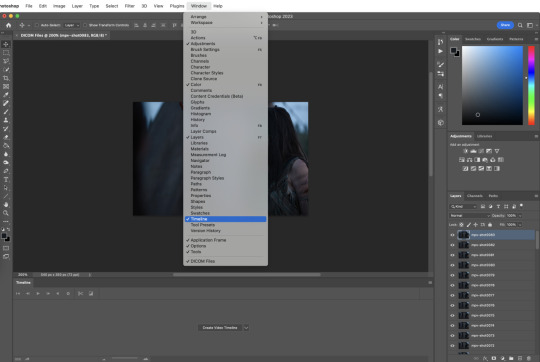
click “create” video timeline in the timeline bar


this will convert your caps to static video layers; we have to do some more work to get a playable animation
6. convert video timeline
click the frame animation in the lower left hand corner of the timeline bar. this will convert your video layers to a frame animation
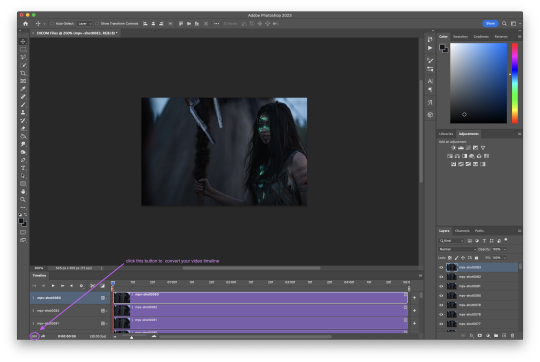
7. make frames from layers
now click the menu button in the upper right hand corner of the timeline bar and select “make frames from layers”; be sure to leave “new layers visible in all frames” checked


now all your frames are visible in the timeline
8. delete frame
with all the frames visible, you can see that the first frame is 5 seconds while all the other frames are 0 seconds. delete that 5 second frame using the trash can icon in the timeline bar. if you don’t delete this frame, your gif will have a ton of lag at the beginning and/or end up with duplicate frames when you export it
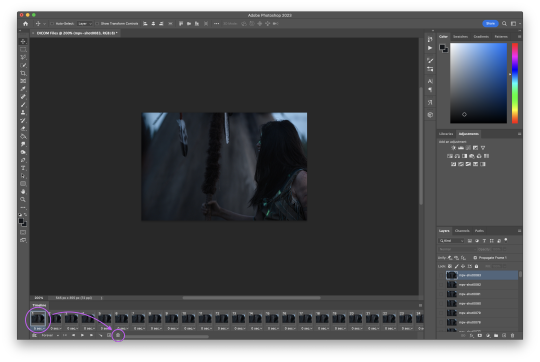
9. convert frame animation
click the video layer symbol in the bottom left hand corner of the timeline bar (where the frame animation button was in step six) to convert your frames back to video layers


they move now! but we want to be able to edit the gif as a whole instead of in individual layers
10. select all layers

11. convert to smart object
so we’re going to turn those video layers into a smart object; the smart object will act as a container that keeps everything neat and tidy while we sharpen and color, and will also preserve the original image, allowing us to edit non-destructively
hit filter > convert for smart filters
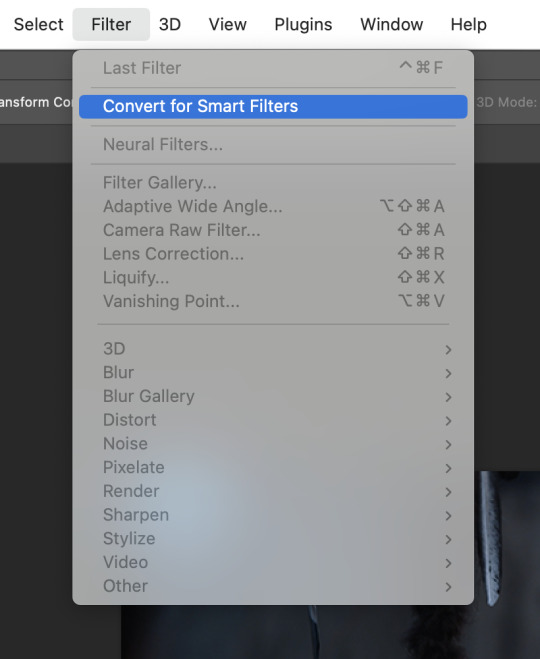
if this is the first time you’ve made a gif, this is a good place to stop and check that everything is working the way it should. play your gif to make sure there’s no lag or any other issues

if your gif only plays once and then stops, go to the timeline menu and select “loop playback”

if there’s some other issue, go back through steps 5-11 and make sure you’ve followed them exactly
12. smart sharpen
sharpening adds back in that nice, crisp clarity that’s lost when the screencaps are cropped and resized to fit tumblr dimensions. there are a ton of different sharpening settings out there, but people generally sharpen in two distinct steps using “smart sharpen”
here is my process:
for the first step, go to filter > sharpen. select “custom” from the preset dropdown. click the gear icon and make sure “use legacy” and “more accurate” are both checked, and then select “gaussian blur” in the “remove” dropdown. finally, set the following values for amount and radius:

13. smart sharpen
my second smart sharpen follows the exact same process as the first—“use legacy” and “more accurate” are both checked—but with different values entered in for amount and radius:

note: like a lot of giffing, sharpening settings come down to personal preference, but be aware that oversharpening can lead to areas of extreme contrast in your gif, and an overall sort of staticky, almost crunchy effect
14. resize canvas + check playback
finally, resize the canvas to remove the 5px gutter we left back when we cropped


you can adjust how long the gif is using the sliders on the video timeline

now look at that! you’ve got a basic gif that’s ready for coloring and text!
note: you might have noticed that i haven’t talked about timing yet, and that the gif is playing way more quickly than the original footage was— don’t worry, we’ll deal with that later, and for good reason
4. ACTIONS
so fourteen individual steps for a gif sounds like a lot, right? but photoshop has a function that takes those steps and runs them for you. behold: actions!
actions are automated processes in photoshop that can drastically speed up certain tasks. steps 5-13 in the giffing process i just outlined are automated in this action*, which means you can load your files into photoshop and have a basic gif ready to go in just a couple seconds
all you need to do is download the action and open it in photoshop, where it will automatically be added to the actions panel. select the one labeled “DICOM ACTION,” press play, and voilà!
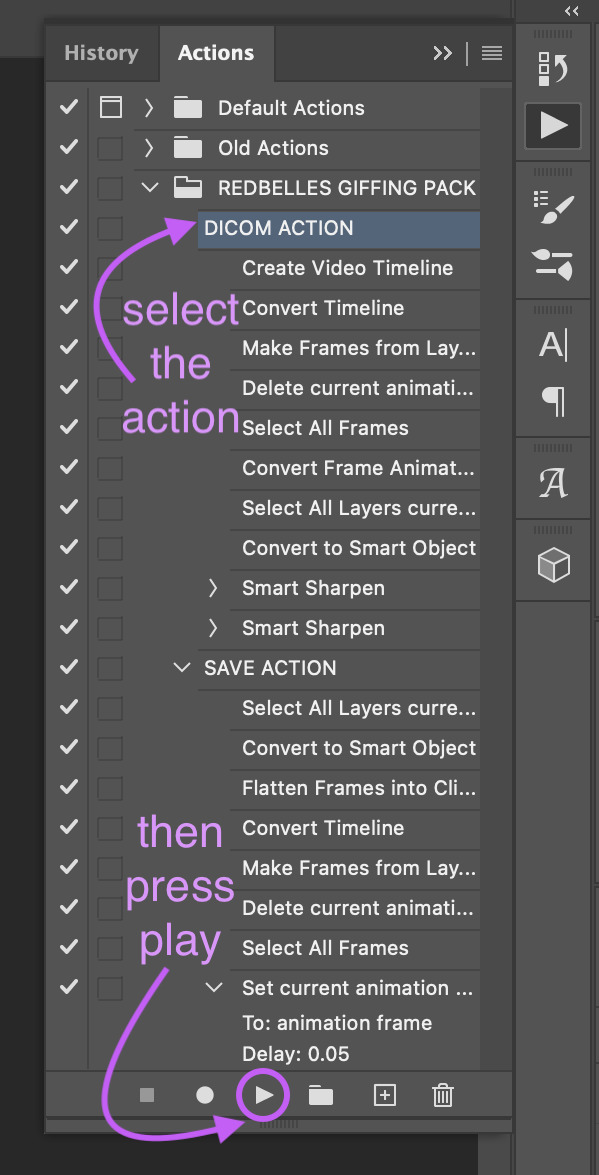
*my action is a modified version of this life-changing action by the one and only rizz (@anyataylorjoy) updated for use with DICOM files and shared with her permission! rizz’s genius save action is also in both of the links above; we’ll discuss that more later
actions aren’t just limited to the actual process of animating a gif, though. you can create custom actions for excruciating fun things like frame by frame coloring (tutorial coming... idk, someday. maybe.) or creating glitch effects
if that sounds like something you’re interested in, here’s a handy official guide on how to create your own actions and some others on how to managing/saving actions if you decide you want to share one
5. COLORING
after nearly four five six years of giffing, i can say with 100% total confidence that there are a million different ways to go about coloring. whether you’re just starting out or you’ve been relying on psds, the best advice i can give you if you want to develop your own style is honestly just to play around with the different adjustment options in photoshop and see what you like and what works for you
of course, that’s easier to do if you have a basic understanding of what each adjustment layer does, so to that end:

brightness/contrast
adjusts the tonal range (the levels between an image’s darkest and lightest points) of an image. brightness slider affects highlights and contrast slider affects shadows
levels
adjusts the tonal values of an image by modifying the level of highlights, midtones, and shadows
curves
adjusts as many values for brightness and/or color as you want across the entire tonal range of an image
note: curves can be used to impact the entire rgb spectrum, or can be used to change r/g/b in isolation
see here for a more in-depth explanation of the curves tool
exposure
adjusts exposure levels across exposure, offset, and gamma. exposure controls highlights, offset controls midtones, and gamma controls shadows
vibrance
adjusts the color intensity of an image via two different options: vibrance and saturation. saturation evenly increases the saturation of all colors in the image. vibrance adjusts the level of saturation of all colors but in a more selective manner, focusing on colors with the lowest base saturation
note: vibrance is less like to oversaturate skin tones than saturation
hue/saturation
allows the adjustment of hue, saturation, and lightness of either the entire image or a specific range(s) of color in an image
note: using saturation across the entire image (the “master” slider) will reduce the overall tonal range of an image and can result in dullness
color balance
adjusts the mixture of colors in an image across either highlights, midtones, or shadows
black and white
adjusts color values to produce grayscale images, with both preset and custom value options
note: using a black and white gradient map instead of the black and white adjustment tool itself often results in a smoother gif
photo filter
adds a single color filter to the image
channel mixer
adjustment option that modifies a targeted (output) color channel using a mix of the existing (source) color channels in the image. color channels are grayscale images representing the tonal values of the color components in an image (rgb or cymk)
note: when you use the channel mixer, you are not adding or subtracting colors to/from a specific color component (see: selective color). instead, you are adding or subtracting grayscale data from a source channel to the targeted channel
color lookup
a set of premade filters/styles to apply to an image
invert
inverts the colors of an image to create a photo negative effect
posterize
reduces the number of brightness values in an image to create a flat, poster-like appearance
note: not typically used in gif making
threshold
adjusts grayscale or color images and converts them to a high contrast black and white images via a specified level as a threshold. all pixels lighter than the threshold are converted to white, while all pixels darker than the threshold are converted to black
note: not typically used in gif making
selective color
adjusts the amount of a primary color in an image without modifying the other primary colors in the image
note: the “absolute” option adjusts the color in absolute values, while the “relative” option adjusts the existing amount of a given color by its percentage in total
gradient map
converts the grayscale range of an image to a gradient color fill, with both preset and custom gradient options available
note: gradients can be manually adjusted, and checking the “reverse” option inverts the colors of the gradient
okay! now that that’s out of the way, here are three narrated examples of how i color:
1. prey (2160p sdr)

[video link]
2. the punisher (1080p)

[video link]
3. house of the dragon (2160p hdr)

[video link]
my general coloring process
step one: lighten
i start with one or two curves layers to see if i like what the rgb “auto” option gives me; if i don’t, i switch to lightening via exposure
if i know from the outset that a scene will need aggressive color correction, i’ll use a curve layer set with the white point eyedropper instead of the auto option; this brightens and color corrects the entire gif based on a selected pixel
step two: darken blacks
it sounds counterintuitive, but as you lighten the scene, you need to make sure you’re not washing it out
i start adding contrast back in by adding +1 black in blacks in a selective color layer below my lightening layer(s)
i often follow that up with a levels layer set to “increase contrast +1” above my lightening layer(s)
if you feel that the “increase contrast +1” layers has made the blacks too intense, you can try a black point layer in levels instead
note: the above/below method is a personal preference based on how the adjustment layers interact with each other
step three: lighten
adding contrast back in can make the gif a bit darker than i’d like, so i typically add another lightening layer after i’ve adjusted the contrast
i generally use the curves “auto” option to balance things back out
i will sometimes use the white point method here (seen in the videos when i zoom to 3000%) either alone or in conjunction with auto curves layers
step four: color adjustments
this step varies the most: in the videos, you’ll see me adjust cyan (prey), take out yellow (the punisher), and amplify red while removing yellow and green (hotd)
if very aggressive color correction is needed, i tend to use channel mixer. otherwise, i use selective color first and then hue/saturation if needed. i do not tend to use color balance
update: explanation of why i avoid color balance here
step five: final tweaks
if a gif seems flat: i increase the blacks in neutrals using selective color to add extra depth
if a gif seems dull: i increase vibrance, or in extreme cases, vibrance and saturation
note: be very careful when using saturation— it can wreak havoc on skin tones
psds
if you don’t want to color manually for whatever reason (don’t have time, struggling with the scene, want to experiment, etc.) psds that others have shared are always an option
psds are adjustment layers that other gifmakers have put together and shared so you can apply them to your own gifs
note: psds are almost always scene-specific (and often file-specific), so you’ll likely have to tweak them to make them work for your gifs
check the resources section at the end of this guide for some places to find psds
6. TEXT
the most important thing about any text layer is to make sure that is above all of your adjustment layers. if your text is below any adjustment layers, it will end up looking wonky and distorted
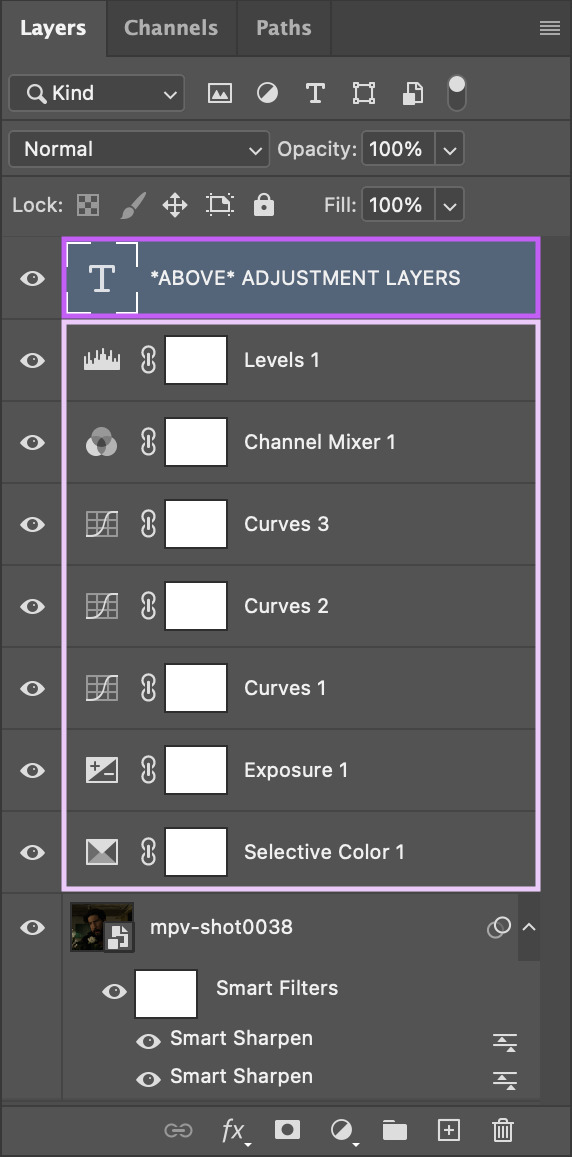
subtitles
first things first: pick a font that is easy to read. i use arial rounded mt bold, but alte haask grotesk, arial, myriad pro, etc. are all good options as well. for subtitles, sans serif fonts are almost always much easier to read than serif fonts
after you’ve chosen a font and loaded it into photoshop, select the text tool and click and drag to create a text box instead of just clicking once to create a text layer. this will help you keep your subtitles perfectly aligned across multiple gifs

type out your text, then click the character option to adjust your type settings. if you can’t see the character option, from the main menu bar go to type > panels > character panel. this will also work to bring up the paragraph panel
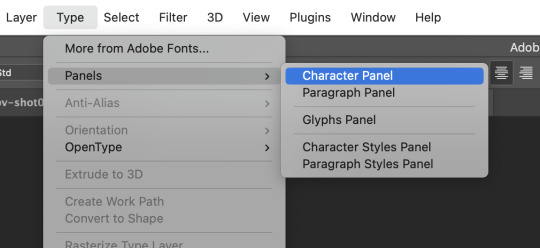
these are the character settings i currently use for my subtitles:
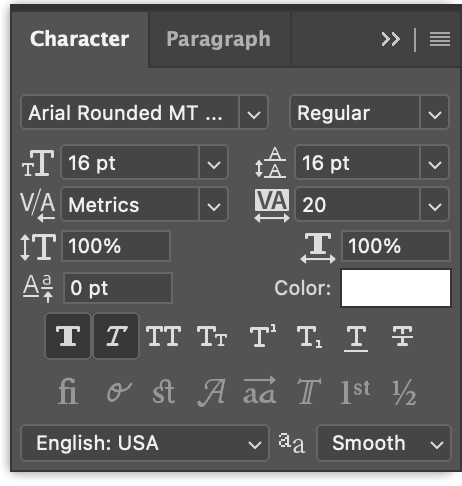
note: the text size can vary from set to set. if you end up changing it, be sure you change the line spacing (the little vertically stacked As directly to the right of the text size dropdown) to match
using either the top text bar or the paragraph panel, make sure your text alignment is set to “center” instead of “left” or “right”
now we need to make the text stand out against the gif. we’ll do this by adjusting the blend options. with your text layer selected in the layer panel, go to layer > layer style > blending options

i personally use drop shadow, stroke, and outer glow for my subtitles:



after you’ve got your text settings the way you want them, press v to select the move tool, then click the three dots in the top toolbar to pull up the “align” menu
select “canvas” from the “align to” dropdown in the menu, then use the center and bottom buttons to center your text at the bottom edge of your gif. the extra space in your text box may provide enough of a buffer to separate your text from the edge of the gif, but if not, simply move the box upwards until you’re happy with the placement

note: if you’ve used a text layer here instead of a text box, the position of your text will be based on individual glyphs instead of the uniform edge of the text box. this means that lines with the letters g, j, p, q, or y will be positioned differently than lines without those letters, which can ultimately mess up the placement of your subtitles across your gifs. save yourself some hassle and use a text box

to make sure the text box ends up in the same place on all your gifs, go to layer > duplicate layer to copy them exactly on to your other gifs


note: be sure to double check the drop shadow on any duplicated layers, since photoshop sometimes changes the angle of the drop shadow to 90° on the new duplicated layers
additionally, if you’re working with multiple speakers, make sure whatever colors you pick for them don’t make the text difficult to read
you can download a base version of my subtitle settings here
other text
you have a lot more options for non-subtitle text: crazy fonts, cool coloring, effects, etc. don’t be afraid to experiment! a good place to start is the layer style tab. go to layer > layer style and you’ll see these options:

we used a few blending options for subtitles (drop shadow, stroke, outer glow) but now you can play with color overlays, gradients, and even patterns
check out the resources section at the end of this guide for font websites, fancy text tutorials, and more
7. SAVING + EXPORTING
timing
now we’re (finally) ready to talk about timing. the frame delay you want to use is 0.05. this timing most closely matches the natural playback speed of (non-animated) footage. anything else is going to be noticeably too fast (0.04) or too slow (0.07). witness:



there are really only two exceptions to this:
animated footage, which can run at a faster frame rate than non-animated footage and may work with 0.04 timing
gifs that have < 15 frames (ex: trailer footage)— you might be able to get away with something like 0.06 in that case, but it will still look a litle slow
most other tutorials have you set your timing as part of the process of animating your gif, but i didn’t. why not? because photoshop absolutely loses its goddamn mind when it comes to gif timing
it will create duplicate buffer frames if you change the default frame timing at all at literally any point except as the very last step before you export your gif. this means that if you change it as part of your process before the “convert to smart object” step, you’ll get those duplicate frames and end up with lag in your gif. it will also automatically reset your timing to 0.07 if you export from a video timeline state. gee, thanks photoshop!
the way most people deal with this 0.07 bug is by exporting the gif, opening the exported .gif file in photoshop, and manually resetting the frame timing to 0.05 before exporting again. however, that’s a lot of work, so aforementioned giffing queen rizz @anyataylorjoy did us all a solid and created an action that will convert your gif back to frames and set your timing to 0.05 with a single click. her save action is bundled together with my DICOM action in the link back in the “actions” section
note: managing your timing like this does mean that when you’re working with your gif photoshop before you run the save action, it will play much faster than it will once you’ve exported it
to export your gif, go to file > export > save for web (legacy)

before you jump in to exporting your gif just yet though, there are some things to consider
upload limits
the current tumblr upload limit is 10mb, which is great for gifmakers— it leaves plenty of space for experimenting with big gifs, crazy colors, and fancy effects like blending and transition
and yet: it’s ridiculously easy to go over that limit! make sure to check your file size before you export your gif to confirm that you’re below 10mb so you don’t run into any upload issues

if your gif is over the limit, try shortening the length of the gif. that’s hands down the best way to decrease the size, but you can also try adjusting your coloring. the brighter and more vibrant a gif is, the larger the file size generally is, so those are good areas to try tweaking if you really don’t want to cut the gif down. high contrast, especially in black and white gifs, can produce large file sizes as well
save settings
your save settings will affect how your gif appears when it’s exported and posted outside of photoshop. there are basic settings everyone has to use (ex: loop forever), but some will ultimately come down to personal preference, so it’s worth knowing what the differences between the settings actually amount to
selective vs. adaptive
selective: creates a color table favoring broad areas of color and the preservation of web colors. this color table usually produces images with the greatest color integrity. selective is the default option
adaptive: creates a custom color table by sampling colors from the predominant spectrum in the image. for example, an image with only the color green and blue produces a color table made primarily of greens and blues. most images concentrate colors in particular areas of the spectrum
dither: diffusion vs. pattern
diffusion: applies a random pattern that is usually less noticeable than pattern dither. the dither effects are used across adjacent pixels
pattern: applies a halftone-like square pattern to simulate any colors not in the color table
note: using “adaptive” instead of “selective” and/or “pattern” instead of “diffusion” will result in larger file sizes
i personally use selective + diffusion for nearly every gif i make, not only because the file sizes are consistently smaller, but also because i think that combo produces the cleanest results. i find that the grid pattern creates is very noticeable/distracting, and that the color clarity from selection almost always beats out the custom tables from adaptive
bicubic vs. bicubic sharper
bicubic: slower but more precise method based on an examination of the values of surrounding pixels
bicubic sharper: a good method for reducing the file size of an image based on bicubic interpolation with enhanced sharpening. this method maintains the detail in a resampled image. if bicubic sharper oversharpens some ares of an image, trying using bicubic
i really don’t like oversharpened gifs, so i exclusively use bicubic
lossy
lossy reduces file size by permanently removing some of the original data
lossy used to be a viable way to decrease the size of gifs before tumblr changed the upload limit to 10mb; now gifs with lossy are visibly fuzzy, making them look lower quality no matter what kind of footage was actually used
if you are using lossy to add a film grain effect to your gifs, use the filter > noise > add noise option instead
note: the best way to achieve a grain effect is simply to use hq footage; larger hq files often have a grain to them that is lost as the files are compressed to smaller sizes
here are the rest of my save settings:
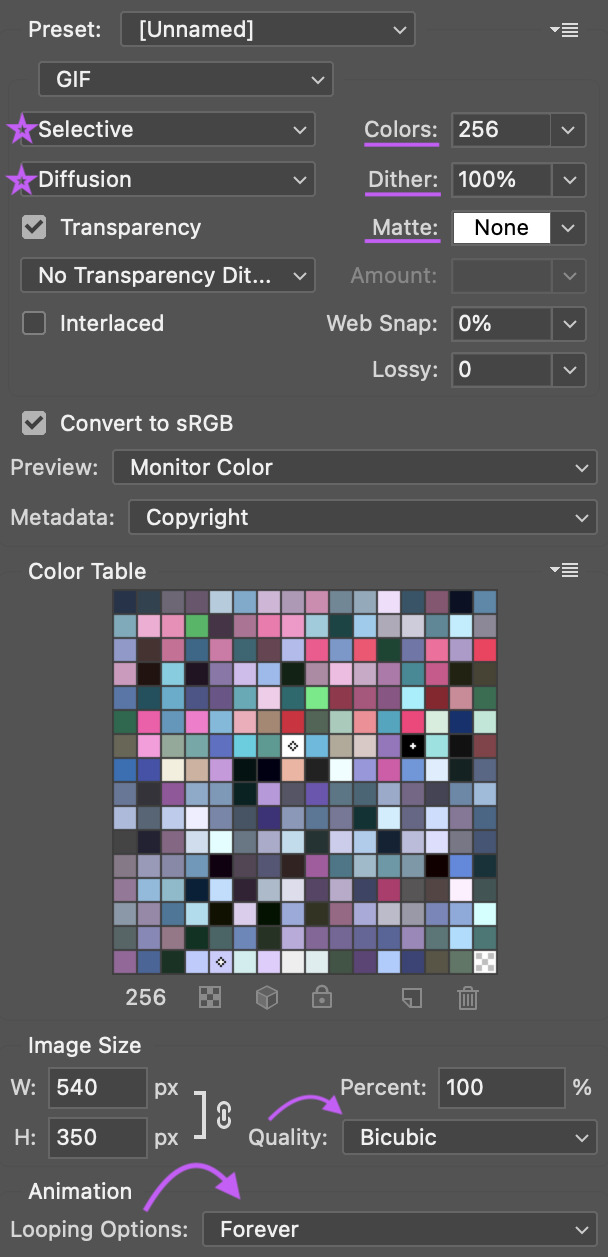
note: the default option under “metadata” includes contact info, so i highly recommend changing that
you can see how a gif will play directly in the export panel, but you can also view it a new browser tab by clicking “preview”; this will open the gif in a new tab in your default browser
when you’re happy with how the gif looks outside of photoshop and have checked that it’s under the 10mb upload limit, go ahead and export the gif
8. POSTING
basics
before we talk about anything else: make sure you are putting your gifs in a photo post. the new editor we’re all forced to use now does a whole bunch of behind the scenes bullshit to gifs (rip legacy editor 💀) and you definitely don’t want to make things any worse by using the wrong post format
if you find yourself struggling with the new editor @wolfes has your back: they’ve put together a comprehensive guide to using/troubleshooting the new editor for gifmakers. everyone say thank you, v!
save in + post from drafts
alright, so you’re ready to post your gifset— while it’s temping to just slap the gifs on a new post and publish immediately, it’s actually a really good idea to save the set as a draft first and make sure the gifs look good once they’re uploaded. sometimes tumblr makes the colors look wonky or wrecks the quality or does other stupid tumblr things, and it’s so much less frustrating to notice that before a set is posted than to see something you want to fix after it’s already out in the wild
if you want some feedback on a draft before you post it, you can click the three dots in the upper right hand corner of the post to open a private preview you can share with others

note: the link will work as long as you have the preview open
once you’re sure tumblr hasn’t messed with anything, it’s time to format the rest of the post
captions
the finishing touch on a set, captions can be anything from basic film/show info to relevant quotes to straight up memes. here’s some general info to help you figure out how you want to format yours
html symbols
edit tumblr posts using html by @hayaosmiyazaki
tumblr html text primer by @gustavlindstrom
gradient text: generate your gradient here, copy the html code here and remove “;” from your text, then paste the semicolon-free text into the html editor on tumblr
note: be aware that the new editor has radically changed how gradient text is processed and displayed. sometimes it works, sometimes it doesn’t. sometimes you can see it on dash but not on individual blogs, and sometimes only the first letter is in color and everything else is black
inspiration credit
if your set was inspired by someone else’s, credit your insp. source(s)
it’s a really basic part of tumblr/gifmaker etiquette that gets ignored way more than it should
there’s obviously a lot of creative drift on a site as big as tumblr and it’s not always possible to pinpoint an exact inspiration source (especially for more popular gif trends), but as a creator it can be really disheartening to see someone swipe something directly from you without saying anything
tl;dr shout out what inspires you!
not sure how to go about crediting someone? here’s a handy guide on inspiration credits from @usergif
tagging
it’s super important to remember that only the first twenty tags on your set will be used in tumblr’s search/tag algorithms!
if you’re not sure where to start, go ahead and check out some popular sets in the fandom(s) you’re creating for and see what tags are on those sets— that’s a great way to figure out which tags are active and what kinds of things you’ll see in them
here are some typical tag categories for fandom sets:
— general tags
media/fandom name: #hotd, #stranger things, #disney
character names: #yennefer of vengerberg, #alina starkov, #ginny baker
ship names: #zutara, #kanthony, #buckynat
— edit tags
#filmedit or #tvedit
#[fandom/media]edit - #swedit (star wars), #nmcuedit (marvel netflix), #tlouedit (the last of us)
#[character name]edit - #rhaenyraedit, #karenpageedit, #batmanedit
#[ship name]edit - #literatiedit, #joenickyedit, #kastleedit
#[actor name]edit - #austinbutleredit, #emmadarcyedit, #pedropascaledit
— source blogs
these are blogs that focus on reblogging a specific type of content (old films, pop culture, etc.) and they’re a great way to get your gifset seen by more people
typically track a specific tag in order to find relevant content
general rule: make your set is the kind of thing a source blog is interested in before tagging them
your set may be reblogged immediately, may go into a queue, or may not be reblogged at all (the members didn’t see it, think it doesn’t fit the blog’s theme, etc.) — just be patient and try to find source blogs that align with what you’re making
examples: chewbacca (#chewieblog), junkfoodcinemas (#junkfooddaily), classicfilmblr (#classicfilmblr), dailywoc (#dailywoc), bob-belcher (#userbbelcher), optional (#useroptional)
— user tags
user tags are unique tracked tags for individuals rather than source blogs!
gifmakers will often have their tracked tag (if they have one) in their blog description/about page
ex: i track #userbells

general rules: you don’t have to be mutuals with someone to tag them, but it’s good etiquette to be following them, and to only tag them in things they seem interested in
after you’ve tagged for exposure, there are a couple more things to consider:
— content warnings
it’s generally considered polite to tag for major content/eyestrain warnings
ex: tw flashing, tw blood, etc.
there are a variety of ways to tag for content warnings - #cw blood, #blood tw, # // blood - just pick one style and be consistent with it
warnings don’t have to be in your first twenty tags (since these tags are used to filter out posts instead of find them) but just having them on the post is helpful for anyone who happens to have a content warning blacklisted
— a tag for organizational use
i typically save the last of my twenty tags for my personal “creations” tag so that i (and anyone searching my blog) can easily see everything i’ve giffed
i use * as my tag and have it as one of my sidebar links for easy access
other examples i’ve seen include “mine: gifs”, “my edit”, etc.
best times to post
despite the ongoing tiktokification of tumblr, the hellsite still doesn’t have the kind of dashboard/feed algorithms that other social media sites do. that said, it can still be helpful to post at specific times to boost how many people see your gifsets
according to union metrics, most reblog activity on tumblr happens between 7pm and 10pm eastern time
however, if you’re giffing something that’s just been released—a new trailer/episode/season/movie—then the best time to post is as soon as you possibly can. tumblr users these days unfortunately prioritize reblogging whatever sets get out there first. that’s great if you can get those sets made quickly, but it can seriously suck if that’s not the case
if you want to hustle and make “new content just dropped” sets as soon as the footage is out there, go for it. if not, don’t put any pressure on yourself to do that; it’s totally fine to gif at your own pace
verify that your set is visible on your dash
as soon as you post, go to your dash and make sure that you can actually see your set on your dash— sometimes tumblr just straight up eats posts, and if you can’t see your set, no one else can either
if your set isn’t visible on your dash, it’s likely either gotten caught in the (terrible and useless) nsfw filter or tumblr is just being stupid
to fix this:
check the post by loading/posting each gif individually to see if one (or more) of them is causing the set to break
change the gif(s) responsible by adding/removing frames, tweaking coloring, etc.
if the gif(s) are still breaking the set, you might have to wholesale replace the gifs with different scenes or post the set without them
verify that your set is in the tags
the other thing you need to check is whether or not your set is showing up in the tags
sometimes a set will be visible on your dash but won’t actually appear in any of them tags. to make sure your set is showing up, check one of the tags by going to the /tagged/[tag] page
if it doesn’t show up, here are some general tips:
wait 5-10 minutes: sometimes tumblr just takes a minute to register the set
edit/remove any links: tumblr doesn’t place nice with links general, and with external links in particular. removing the “s” from https in your links can often fix things, but if that doesn’t work, remove the link entirely
try deleting and retyping the tags
try this image trick from @yellenabelova
delete the set and repost from scratch
for a much more comprehensive guide on what to do if your set isn’t in the tags, check out this very extensive solutions flowchart by @momentofmemory
9. RESOURCES + GENERAL TIPS
giffing communities
find some buddies to gif with! giffing is super fun, but it can also be finicky and frustrating, and having people to brainstorm/complain/share things with is honestly so helpful. some of the most fun i’ve had giffing has been sitting around commiserating on a call with rizz or lia or m, or whining at kumi or neve over text chat
some places to start if you’re looking for communities to join:
creatorhub*
@villainelle’s giffing discord (send an ask for a new link if expired!)
the gifmakerhub discord, run by @wolfes
*the creatorhub link is best accessed on desktop, as it will take you to a submission box:

reblog yourself
this is a big one! time zones are a thing, and on top of that, it’s almost impossible to get a reblog in this economy. boosting your own sets is a really good way to make sure more people see them, and also to just take a minute and be proud of what you’ve made!
resources
general photoshop resources
@chaoticresources
@completeresources
@rresources + bonus beginner’s guide
@hisources
@evansyhelp
tutorials
anti white-washing by @haldi-archived
anti red/orange-washing by @aubrey-plaza
channel mixer by @aubrey-plaza
multiple gifs on one canvas by @nataliescatorccio
blending by @nataliescatorccio
fade transition by @anyataylorjoy
coloring dark scenes by @sluttyhenley
transition tutorial by @wolfes
glitch effect by @sarah-snook
gif overlays by @ezrabridgerr
general coloring by @the-borgias
general coloring by @magnusedom
rainbow coloring by @rhodeys
text effects by @unadulteratedloathings
shuffle texts by @cal-kestis
animated handwritten text by @mxrisacoulter
comprehensive subtitle guide by @clubgif
fonts
— where to get fonts
dafont
befonts
ifonts
dafont free
google fonts
— identifying fonts
what the font
what font is
font squirrel
identifont
— font recommendations
@yourfonts
font tag from @anya-chalotra
favorite font combinations from @usergif
font packs from @liohnelmessi
font tag from @itsphotoshop
typography and font pairing guides from @momentofmemory
how to pair fonts by @awildling
psds
@dailypsd
@colour-source
@psdland
+ bonus anti white-washing psd by @evansyhelp
sharpening settings
action pack by @throwing-psds
action pack by @maziekeen
action pack by @daenerys-stormborn
settings from @anya-chalotra
and finally:
don’t stress
that is honestly my most important piece of advice. if you find yourself chasing notes, getting frustrated with low engagement or terrible like-to-reblog ratios, frazzled trying to make sets for new content as quickly as possible— just take a breath. take a step back if you need to. gif what you want to when you want to
giffing is a hobby! it should be fun! don’t let the numbers ruin it for you <3

feel free to send me an ask if you have any questions! previously answered questions are in my giffing help tag
i hope this tutorial helps! if it did: please reblog it!
(and if it really helped, consider throwing me a bone on ko-fi or commissioning something from me? area woman unfortunately very broke)
happy giffing ✨
#completeresources#rresources#usergif#userrizz#userpayton#userkd#jokerous#userriah#userchelsea#userneve#resources#tutorials#gif tutorial#re: gif tutorial#*#@tumblr formatting gremlins let me live challenge#please i am begging#anyway if you see a typo no you don't
4K notes
·
View notes
Text
0 notes
Text
I’ve been avoiding ReShade because I’m a gameplay-driven player, and I don’t want to screenshot production to get priority over my gameplay. I also don’t edit my screenshots beyond lightening up some night shots. I really want my storytelling to come from my game.
However, I’ve been reading more about it, and I guess there are some settings are gameplay compatible, provided you have a studly enough computer -- which I MIGHT have. My computer is plenty studly, but I’m running Sims 3 inside a Windows virtual machine on a MacBook Pro, so I don’t know how much power I really have under all those layers.
I read the tutorial on MTS, which refers to ReShade version 2.0. Some stuff I’ve seen on searches about ReShade + Sims 3 have talked about upgrading to 3. Then I went to the ReShade site, and the current version is FIVE (5).
So... TS3 users, what version are you running? Is there a reason to run 2 or 3, or is the right thing to use the the current release? Do you have any downloadable presets you recommend of the flavor, “Vanilla but better?” that are gentle enough for gameplay?
20 notes
·
View notes
Photo

not sure how to make an introduction for this tutorial. i might have gone too extra because it’s so long...but this is highly requested and i said i would do this as detailed as possible, so here we go!

adobe photoshop 2018 (ahoy, matey!)
topaz lens effects (just for grain)
srwe (sometimes, but not for this tutorial)
reshade (i dont use a specific preset)
drawing tablet (wacom intuos art)
macbook pro mid-2015 (but bootcamp)

//part one
grab a screenshot from your own lovely screenshot folder! mine is straight from my reshade screenie folder. then crop it how you like it! my original screenshot size is 2560 x 1600, and i almost always cut the background out. this is how i do it:
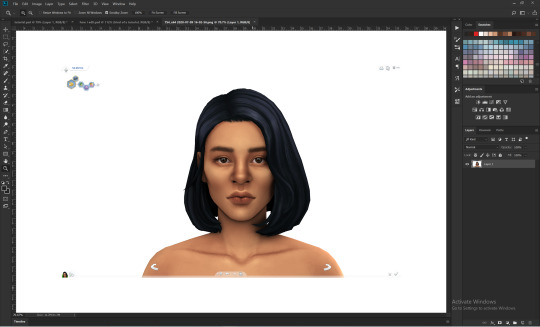
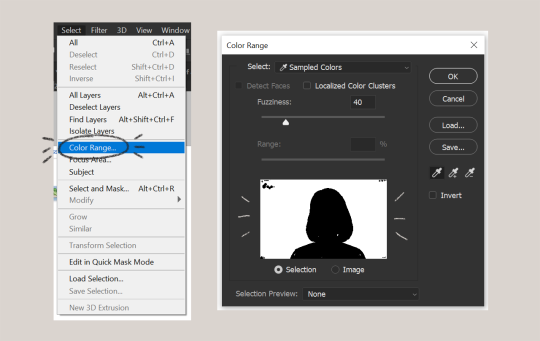
click color range, then click on the background of your sim. the little screen above will look like that. the background should be white. it’s easier when it’s a fully solid color. those are my settings above. click ok! the selected area will have those teeny tiny marching ants.
click quick selection tool, then select and mask...
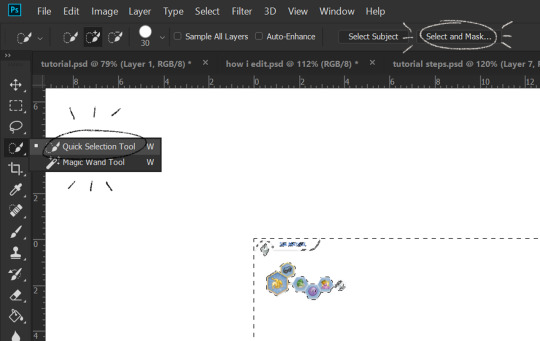
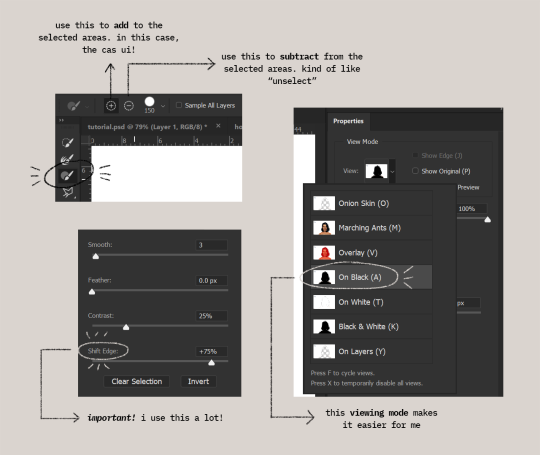
i drew over these circled areas using the “add brush” i showed above. use “on black” viewing mode, then make sure that the sim is completely filled black (it’s the unselected area). use shift edge so there wouldn’t be any of the original bg left over. my settings are shown above. then click ok if you’re all done. press delete and then ctrl + D to unselect. the marching ants should be gone. go ahead and crop it!
after cropping, i resize the width of the photo to 1280px! always!
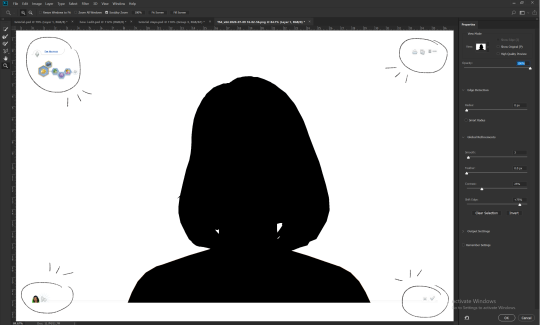
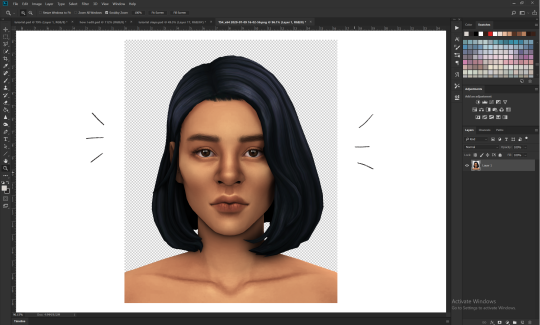
i create a new layer for my background, then add in the psd that i use for my edits. (i hide my psd layer while drawing)
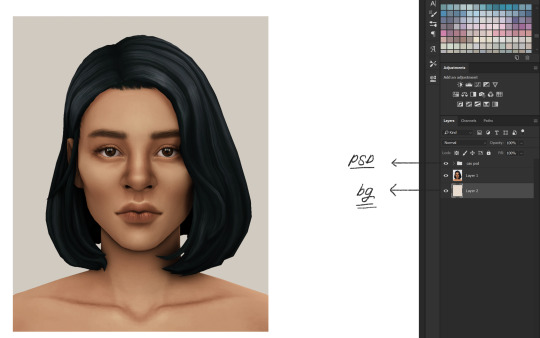
sometimes i also use liquify to edit things like this:

//part two
i use a soft round brush to do everything! it’s literally from adobe, but i changed a few things like the flow jitter in transfer.
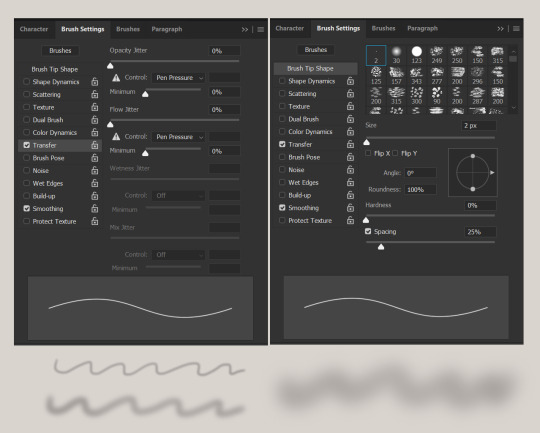
red areas are usually where i put the shadows, purple areas are usually where i put the highlights
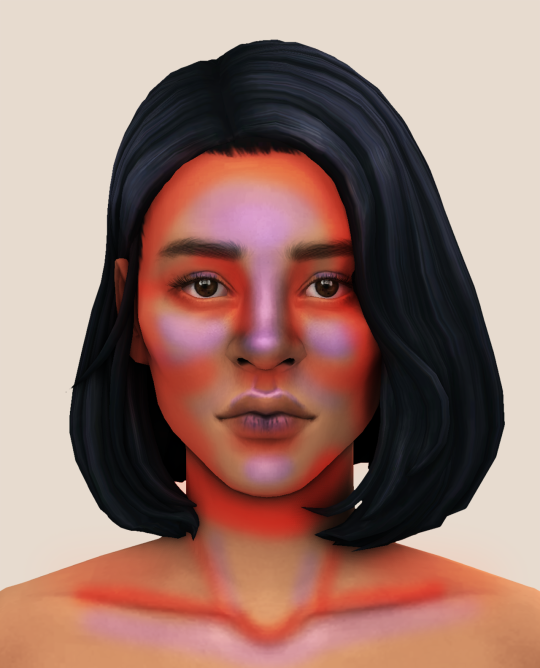
i usually do the shadows before anything else! it’s pretty simple. using the brush i showed above, i create a new layer.
use the eyedropper tool on her skin, then pick a slightly darker shade. change the blending mode of the layer to multiply, then draw the shadows.
right click on the layer, then select “create clipping mask” to make your life a little bit easier. an arrow will appear beside your layer.
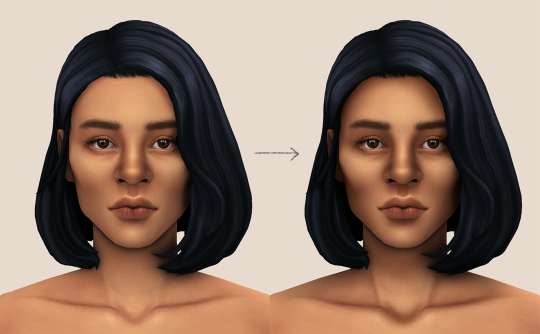
//part three
this is where i draw over the features. let’s look at her face. these are basically what i think it needs:
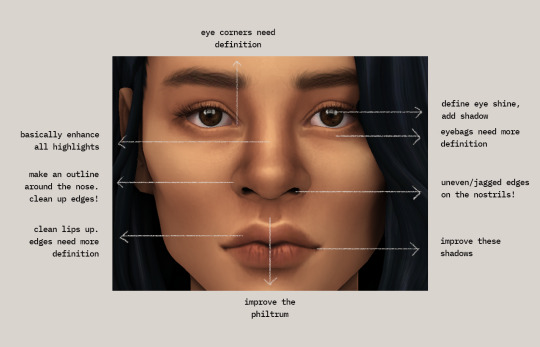
pay close attention to the imperfections and clean it up! that’s what makes it “sharper” in my opinion. small brushes will do the job! something like this:
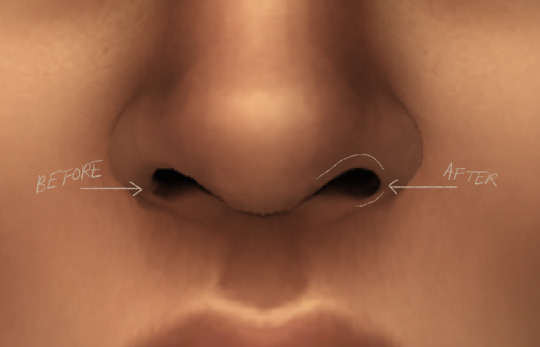
define the edges!!! define!! zoom in and take a look!! even though these are tiny little details, it makes a whole lot of difference! the eyedropper tool is your best friend!
i start with a big brush and then i use smaller and smaller ones as i go, which creates the sharpness. go a little darker as well! im not very skillful with my graphic tablet, so i add stuff bit by bit since it tends to become too harsh when i just go for it! im not as talented as some of u here ;-; i just wing it and pray it doesnt look too bad. half of the time im just experimenting since i literally do not know where some shading goes
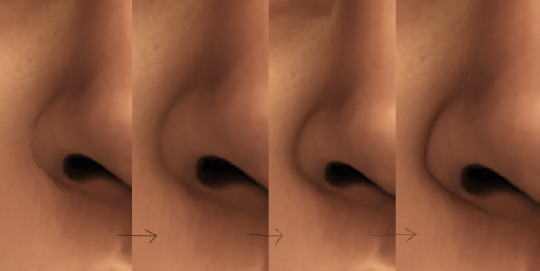
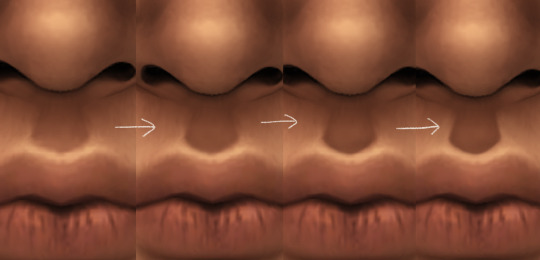

i wont be showing every single thing, but basically that’s the idea! i’ll add in the stuff i pointed out above and more shadows. sometimes i might turn down the opacity of some layers if they look a bit too much. here’s what we got so far:
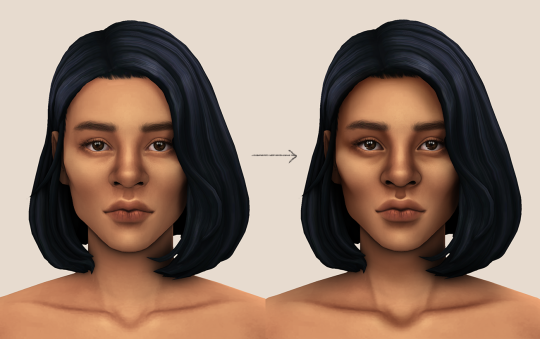
i also like adding some face pores using this amazing “skin texture 1″ brush from this brush pack!

//part four
for the highlight layer, i change the blending mode to either overlay or soft light. use a slightly bigger brush for the bigger areas. use the eyedropper tool on her skin, and instead, pick a lighter shade.
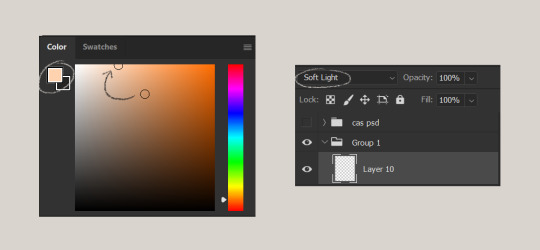
let’s start adding highlight to the purple areas i marked above!
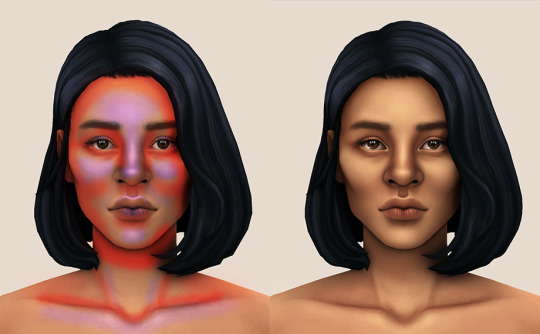
try to enhance the highlight on tiny details too such as the eye corners! if you want something more dramatic, create a new layer and do an overlay layer this time! don’t be afraid to add some on the hair, eyes, lips etc.
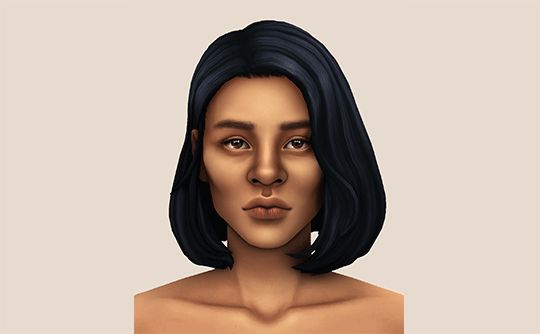
//part five
ok lets add some not decent looking hair strands. i almost always avoid this part because i literally have 0 idea on how to draw hair. i use the “hair base” brush from the same brush pack i linked to above and also have smoothing on to about 35%! the eyedropper tool is still your best friend! just follow the flow of the hair and i guess you’ll be fine ???
i’ll also fill in the annoying gaps beside her neck
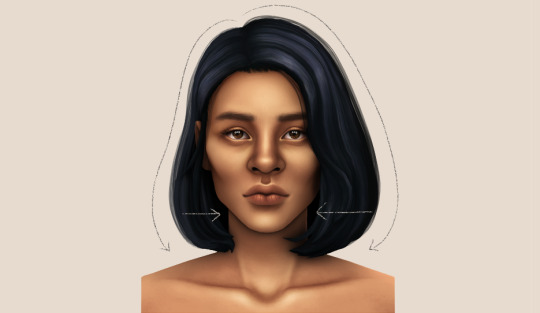
unhide your psd layer and wooowweee
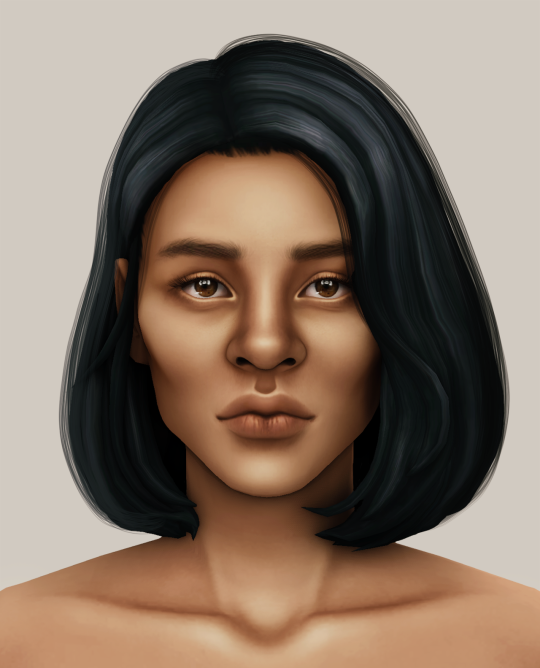
//part six
select all the layers, then click create a new group!
select the new group, then hit ctrl + J or right-click the new group, then click duplicate group
right-click the duplicated group, then click merge group!
i do this so i have a backup of the collapsed layers and can make changes anytime.

i use the sharpen brush on small details i circled below. i used to do stylize > oil paint or topaz clean before, but since the personal action that i use blur things a lot, i try to keep small details visible and sharp.
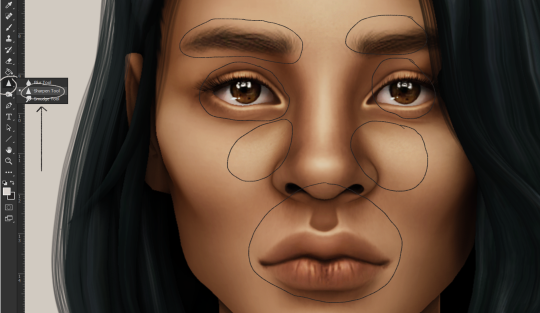
next is smart sharpen, my settings are below. sometimes i go for a smaller radius, but it looks like this most of the time.
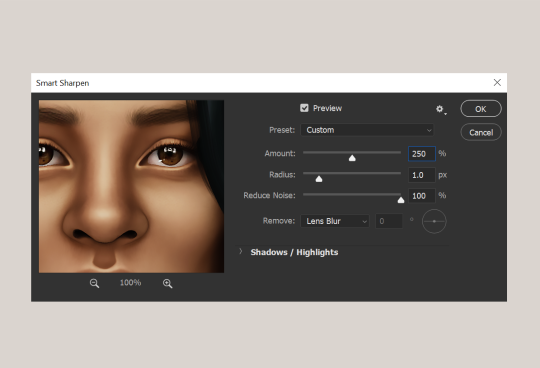
my personal action set consists of this:
duplicate the layer that you just used smart sharpen on, then click lens blur!
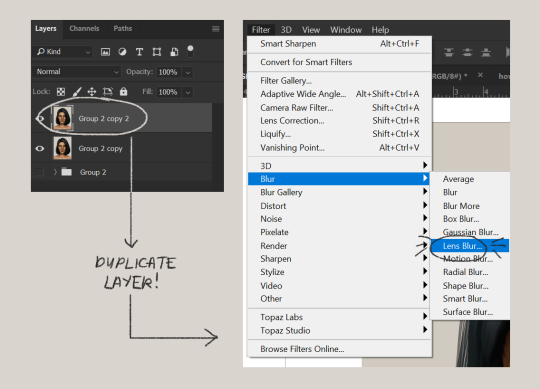
below are my lens blur settings
turn the opacity of the layer (that you just put the lens blur on) to 40%
select both layers, right-click then merge layers!
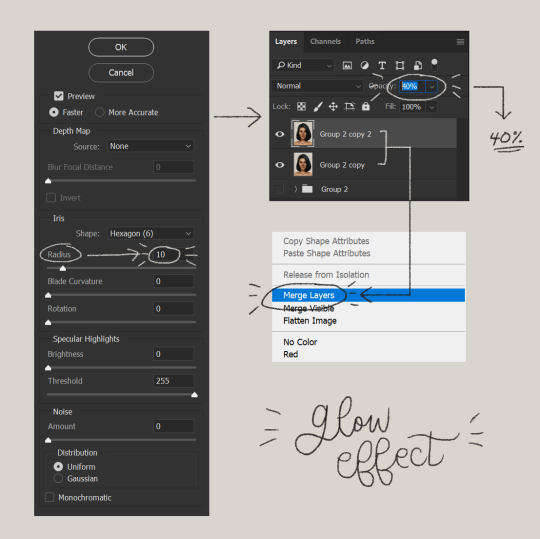
duplicate the layer again (yes, again) then right-click, choose blending options.
uncheck the R located on the “channels” under “advance blending” then click ok.

an icon will appear on that layer!
make sure you have that layer selected, then click the Move tool
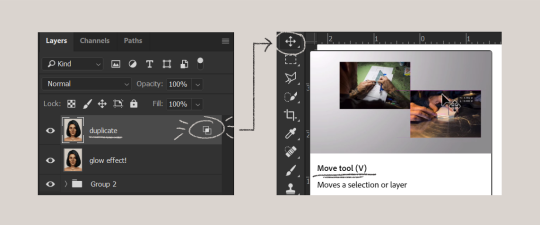
then hit your arrow left/right key once or twice! i do it once because i only want a subtle 3d effect! go ahead and merge those layers!
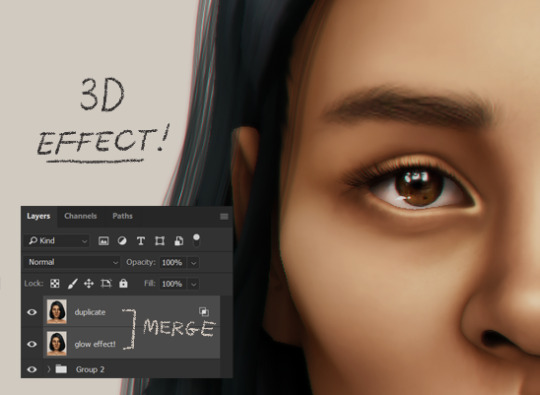
last step is the grain effect. i use topaz labs > topaz lens effects. if you don’t have this, you can also use filter > noise > add noise that photoshop has.
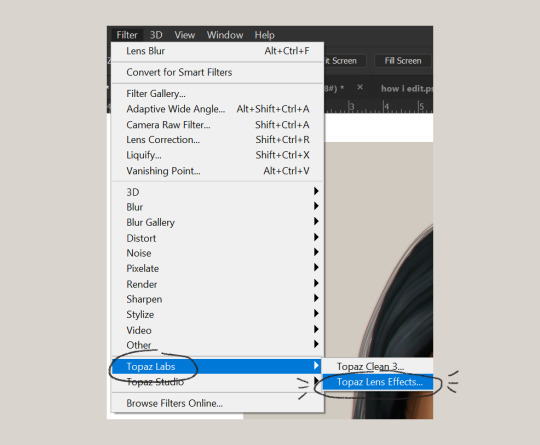
these are my settings:
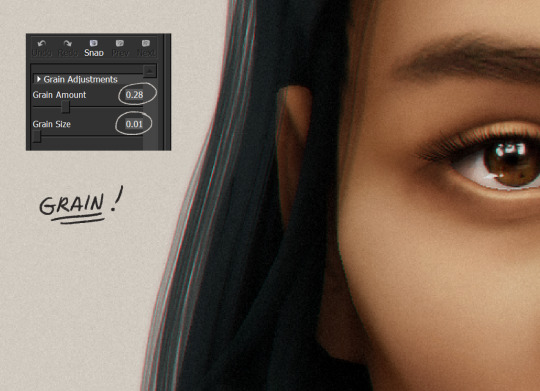
//final look!
here’s a before and after gif! (here’s the finished edit) i hope everything’s clear! i’m really bad at explaining things (っ˘̩╭╮˘̩)っ
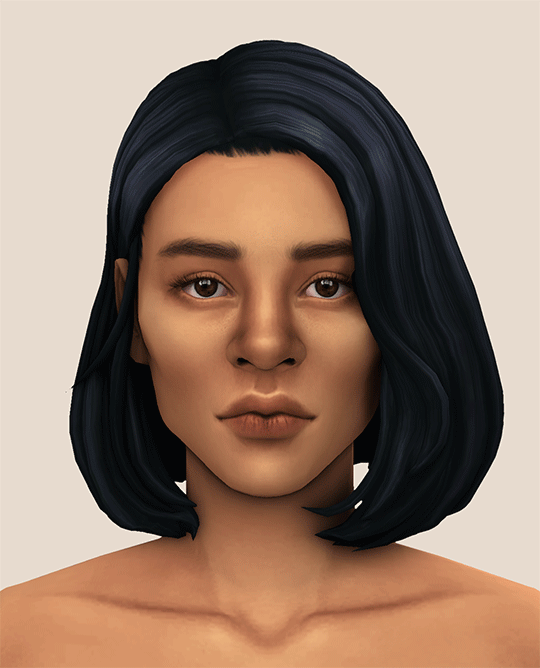
feel free to tag me when you use this tutorial for an edit!! i would like to see it! i hope this helps! ♡\( ̄▽ ̄)/♡
2K notes
·
View notes
Note
I saw that you’re on a MacBook and I am as well and I was just wondering how you get your shadows like that? Or if you know of any good tutorials that could help me? All I’ve ever really wanted are some good shadows :,(
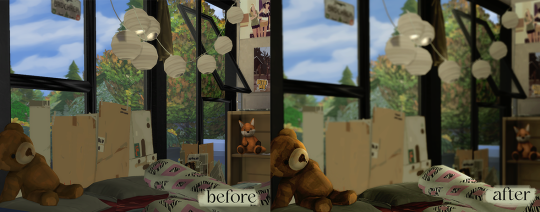
omg i just realized you only wanted to know about shadows and i just made a full tutorial but i... tried my best… aaaaa
what i use: a macbook pro, photoshop cc 2020, topaz clean 3
what i don’t use: reshade, SRWE
what you need:
photoshop cs6 (p*rated — photopea, gimp or paint.net are free alternatives)
topaz labs (free)
topaz clean (p*rated)
download my actions and coloring psd’s
u can download all of them at once here, or:
psd 163
psd 176
psd 24 “pancakes”
avonlea’s actions
i take a screenshot on the sims (w the highest “ultra” settings)
i open the screenshot on photoshop and crop it to my liking (i usually zoom in quite a lot)
i immediately run the action called “super smooth” from avonlea’s actions, linked above. this opens topaz clean for a second and automatically applies it to my photo! now it looks smoother.
i rasterize the pic & duplicate it just in case, bc i’m gonna do some changes to it
with the “quick selection tool” and the “polygonal lasso tool” i select the parts of the image that i want to blur out.
i go to filter > blur gallery > field blur, and i use around “15-20px” depending on the picture. you can also add “bokeh”, just play with it! — press okay
the part that i selected before should be blurry now. what i do next is duplicate the layer again, and I add some more blur to some other parts with the “Blur Tool”, and also sharpen (only a bit) the parts that are more important from the part that isnt blurred
i duplicate the layer again and with the “Dodge Tool”, i draw on top of it to apply some shadows. i usually shade the borders of each object to mimic reshade’s shadows. *here’s a great tutorial made by pea-milk on how to shade your sims tho im lazy and dont do all that
i add the 3 coloring psd’s mentioned above, i group them in a folder and i decrease the opacity to about 15 or 20%!
tl;dr — screenshot, run super smooth action, select what u want to blur, add field blur, dodge tool for shadows, add coloring psd’s
126 notes
·
View notes